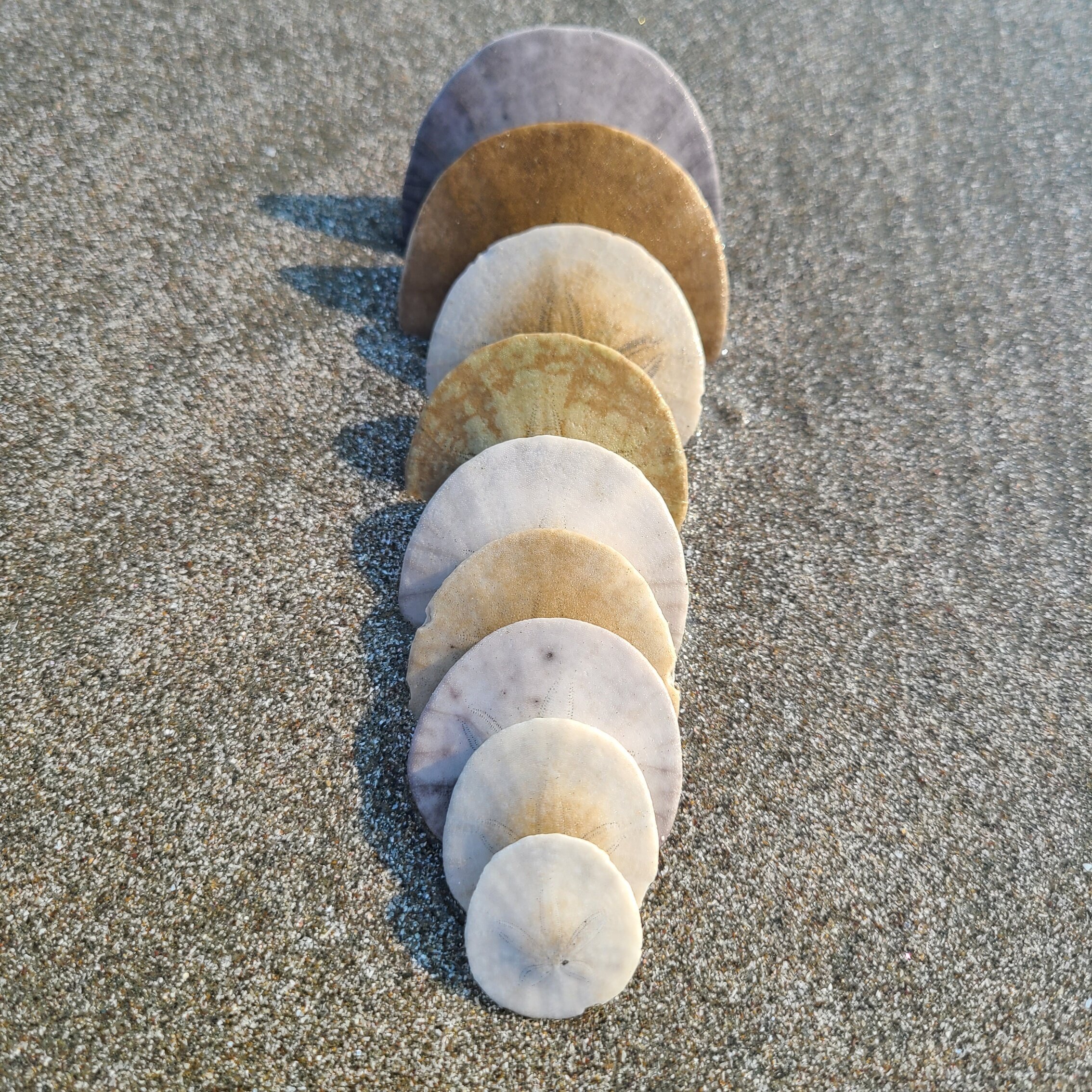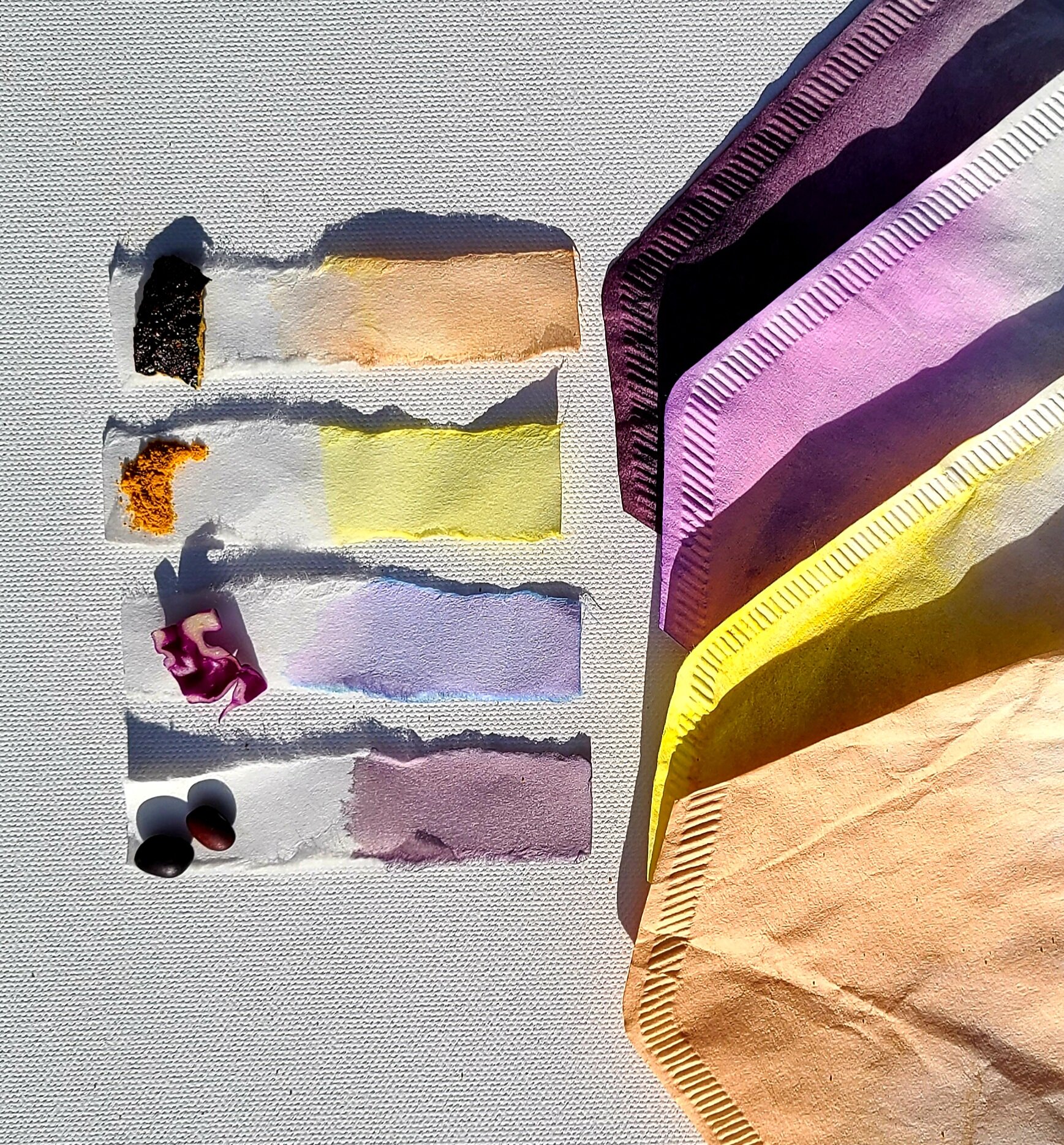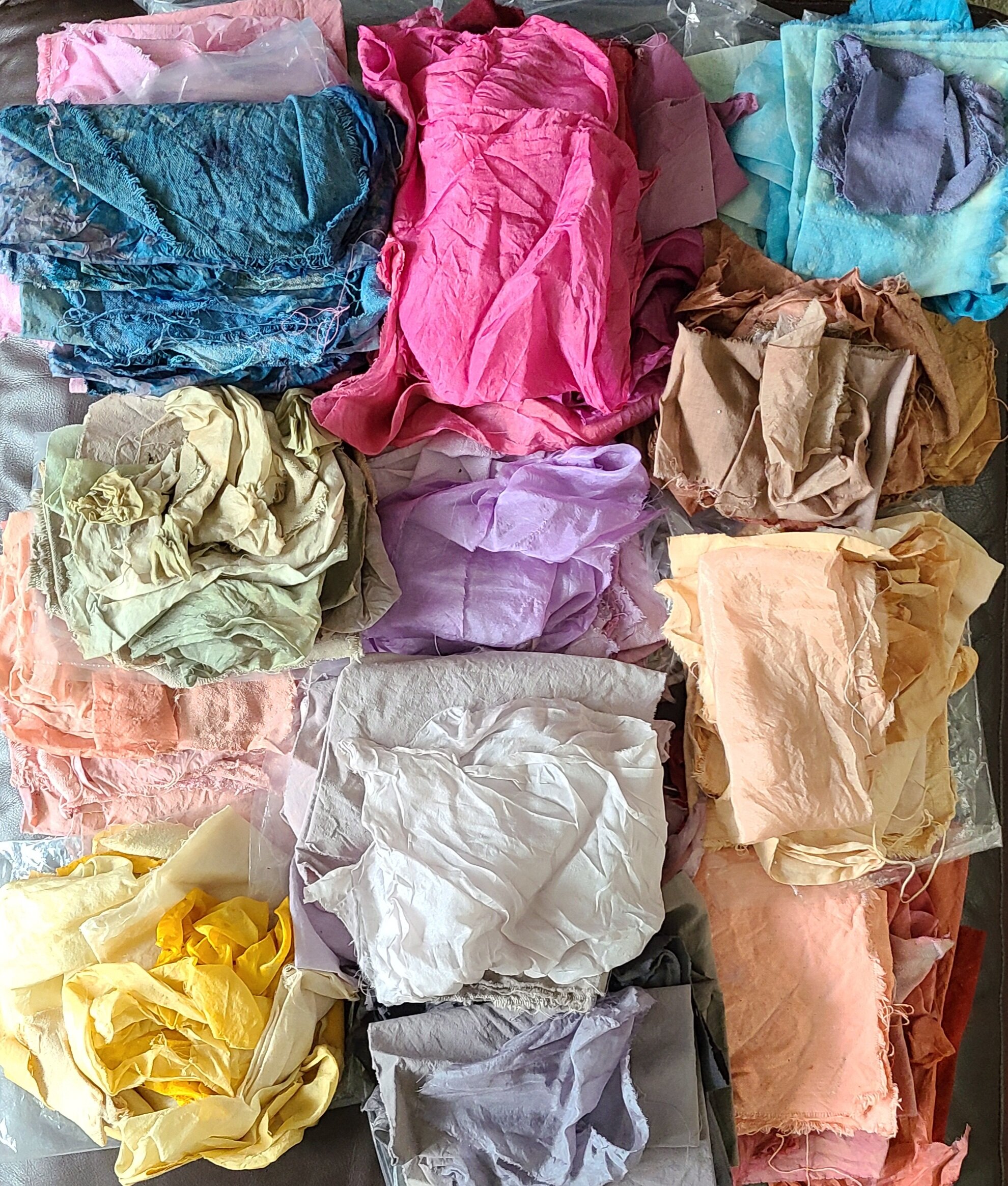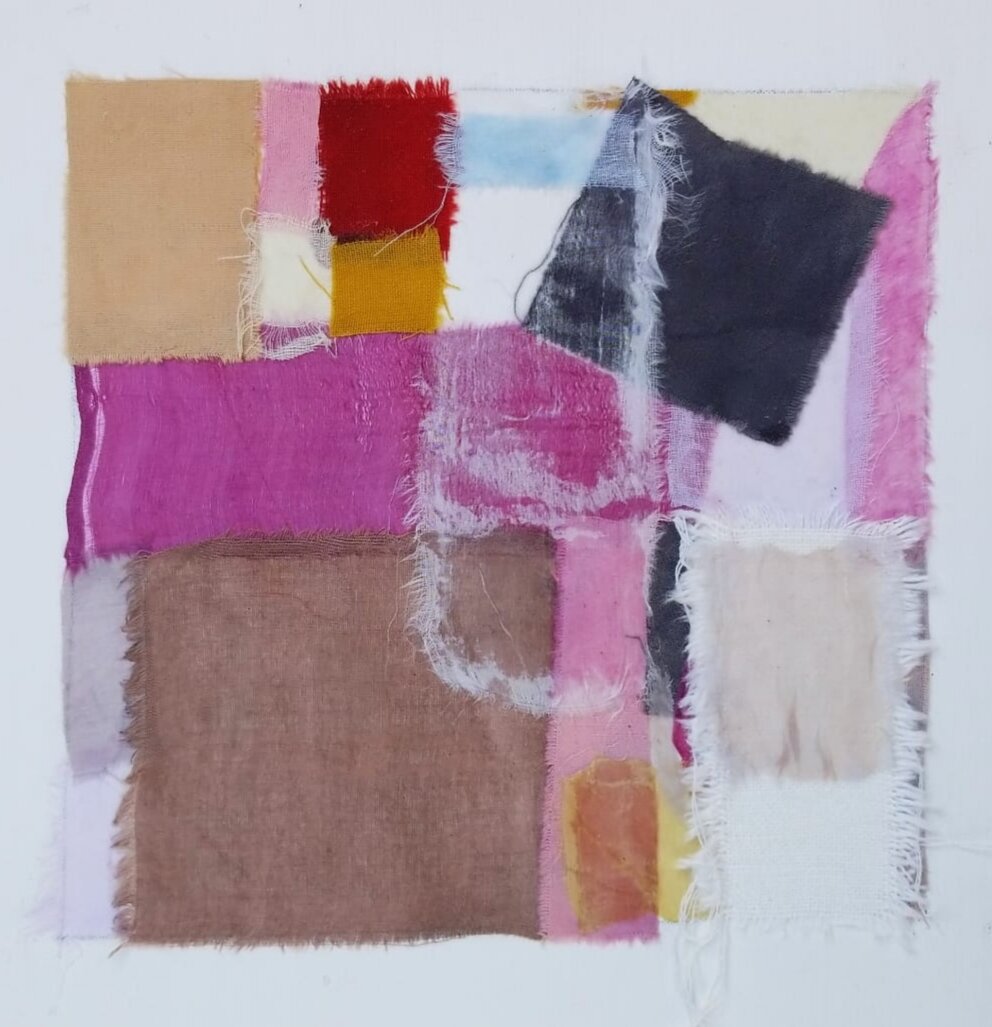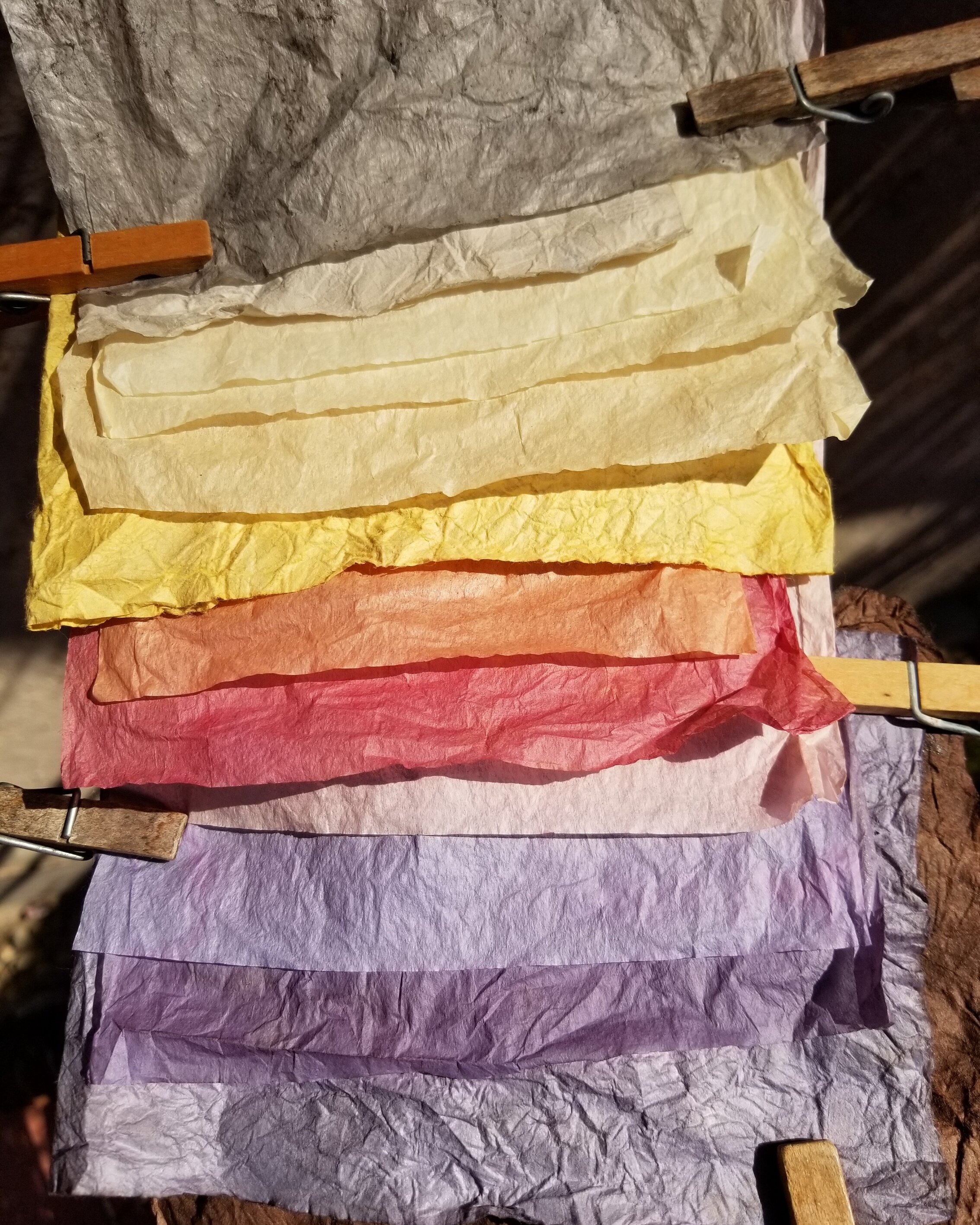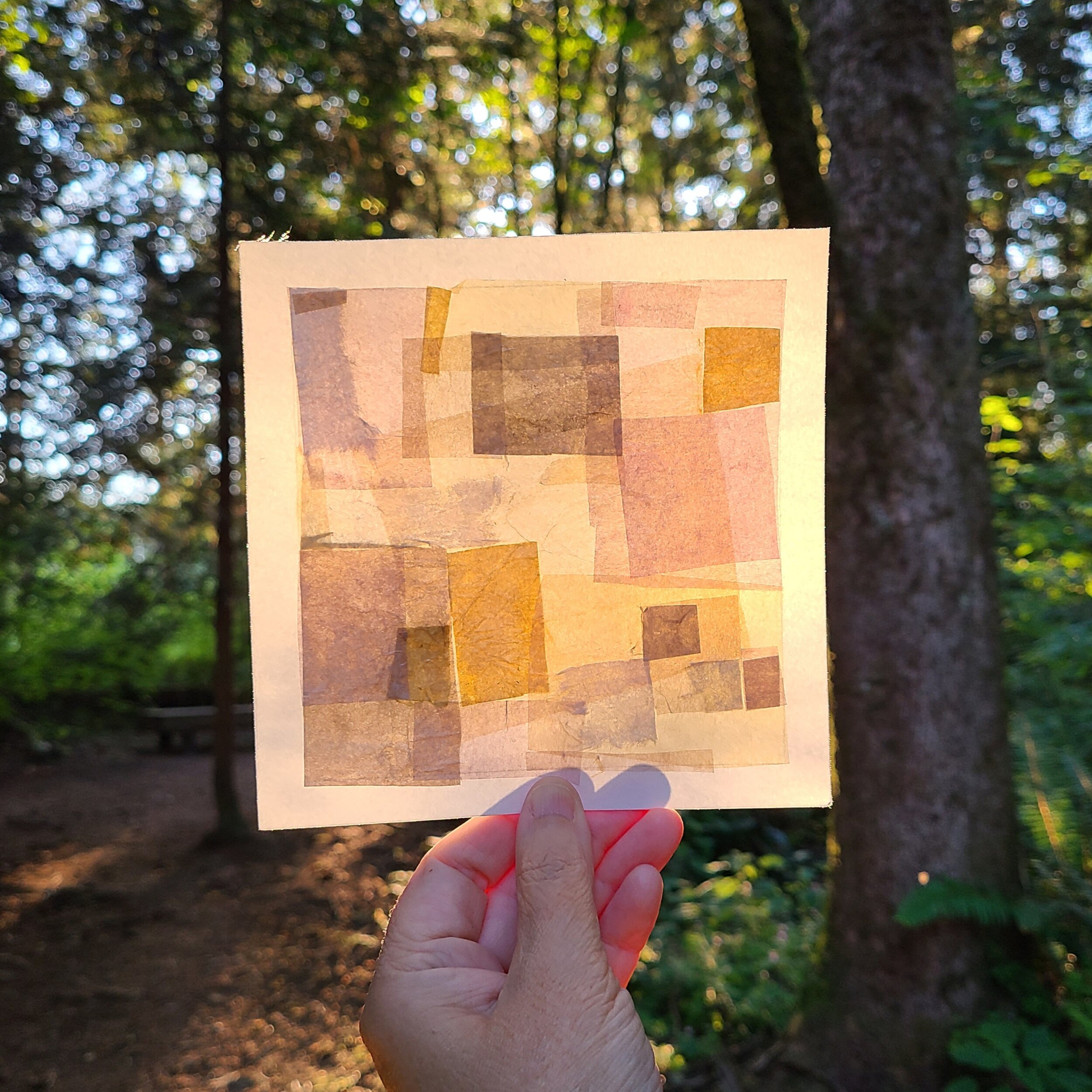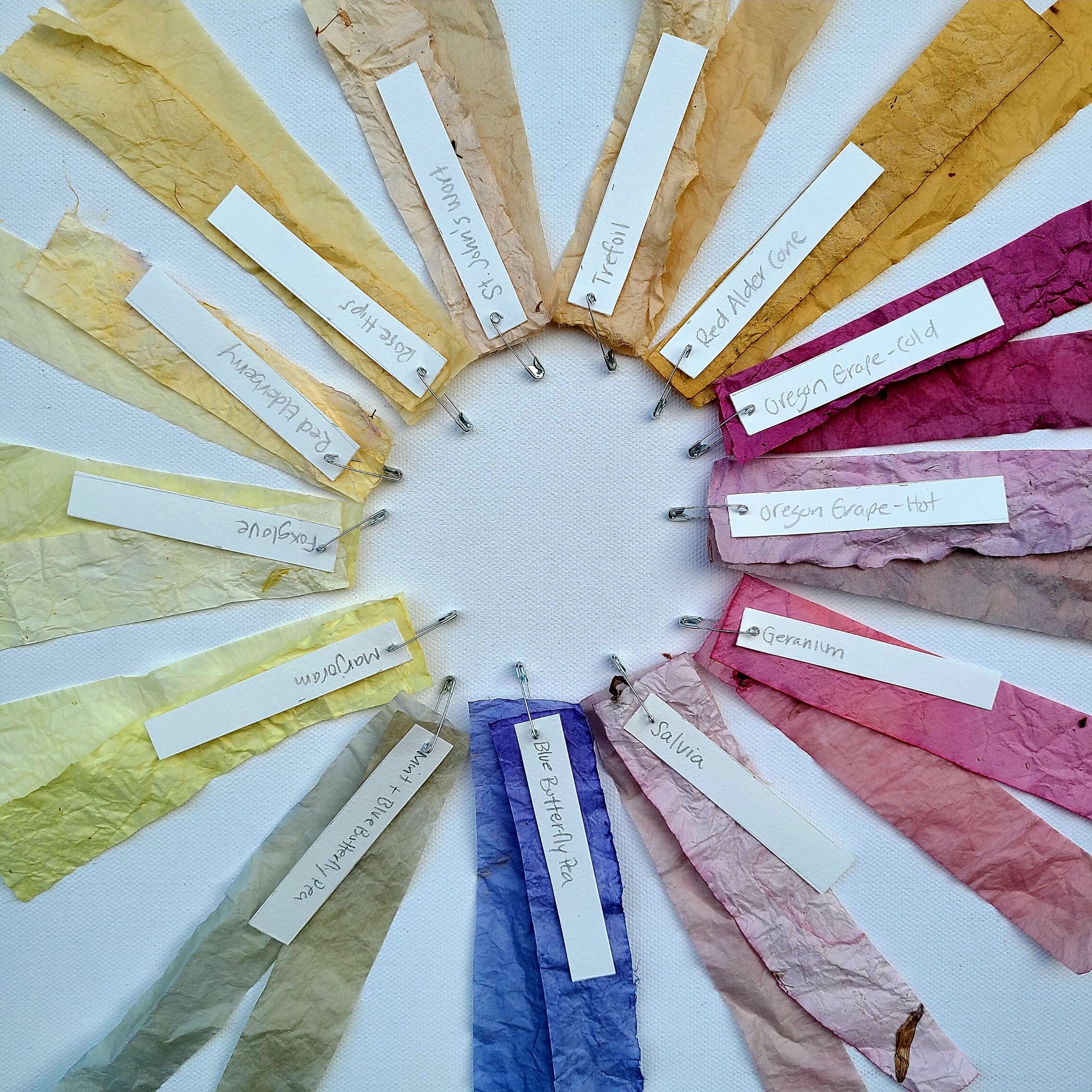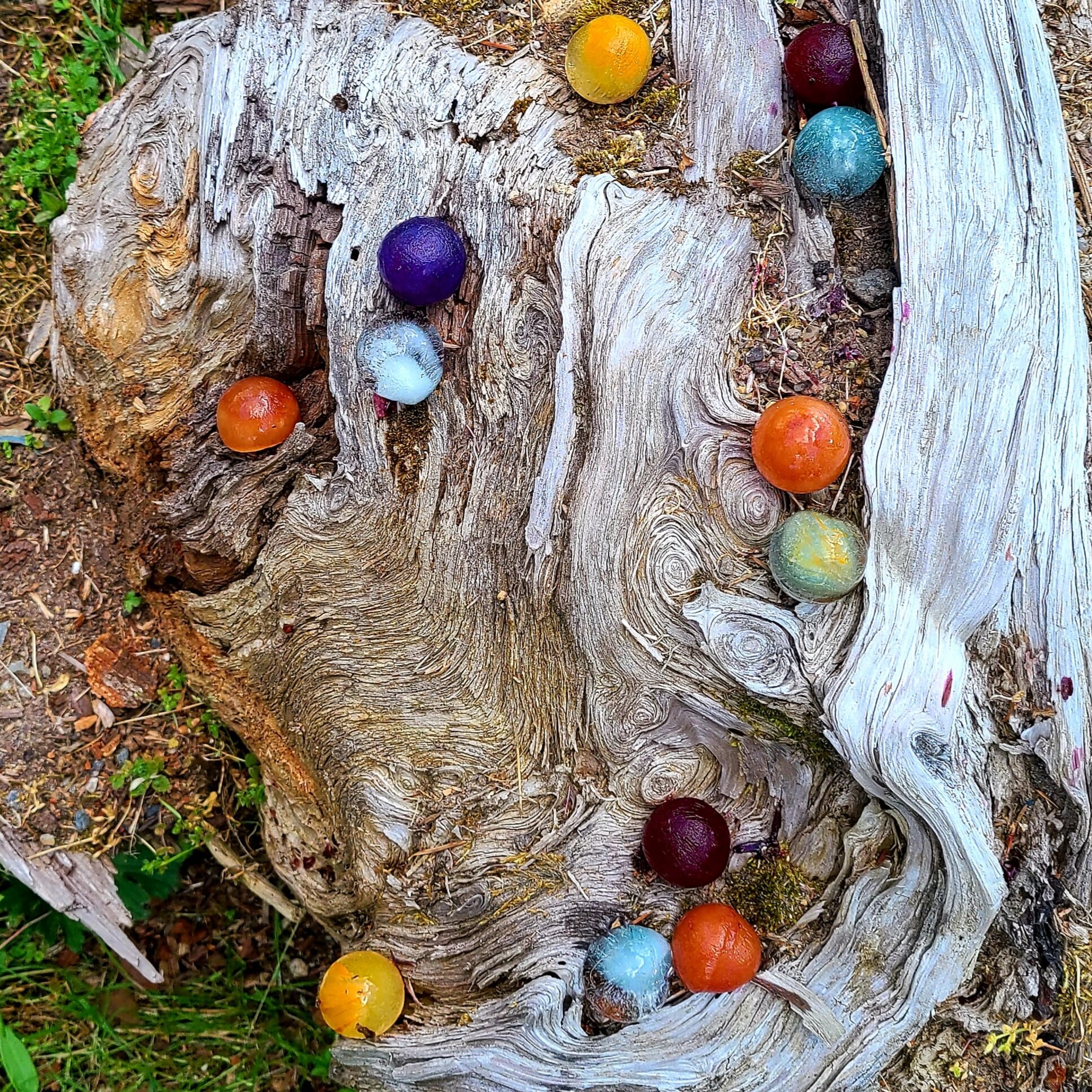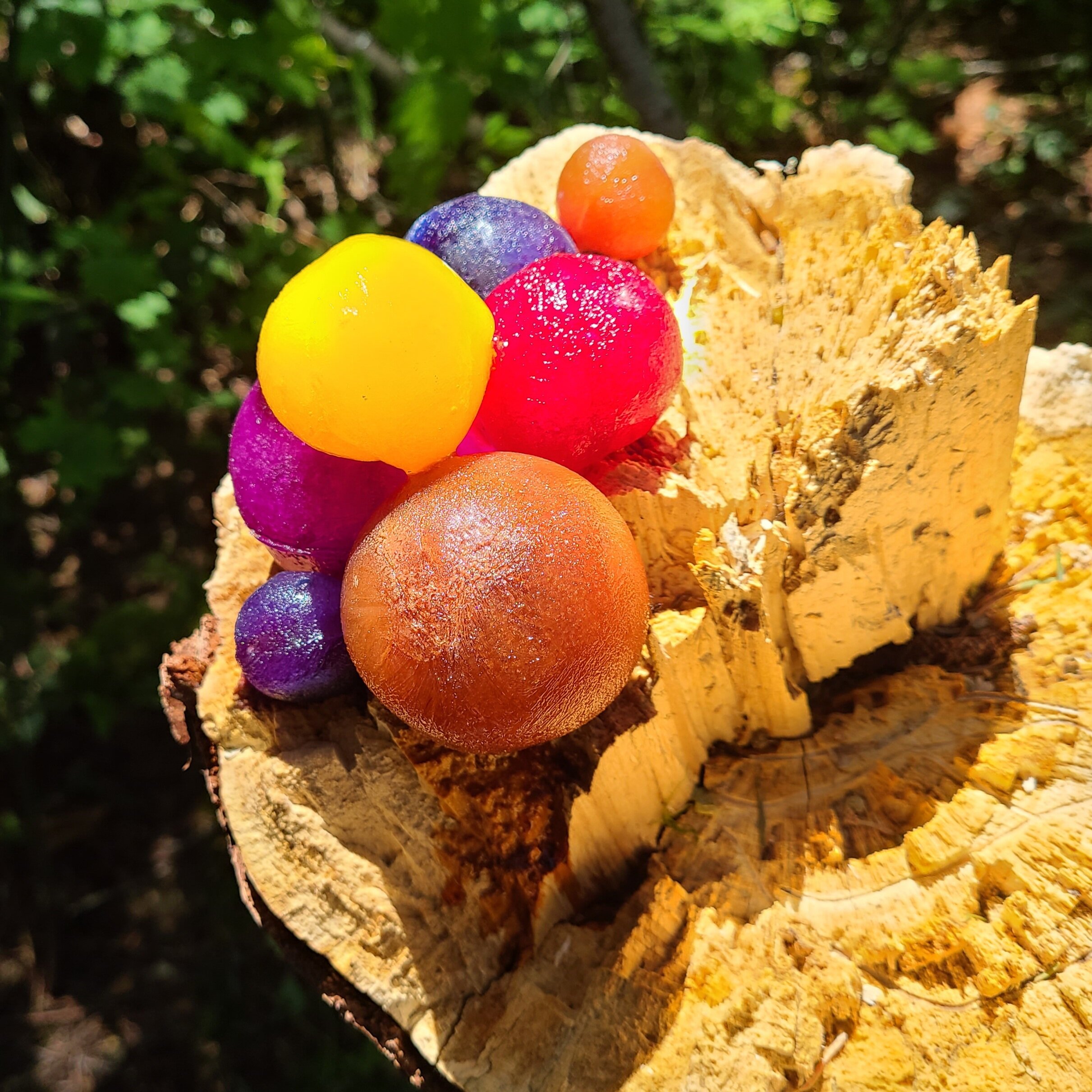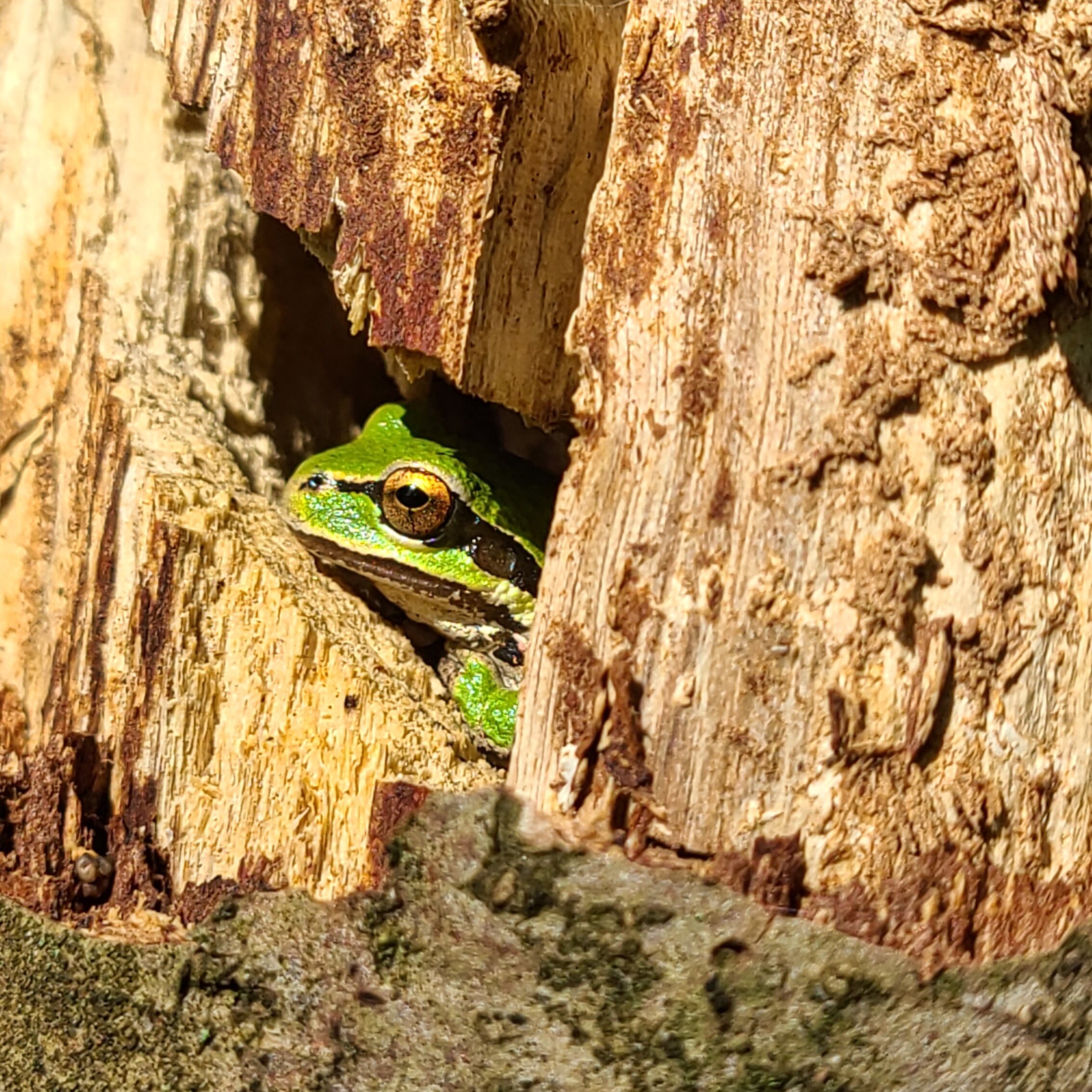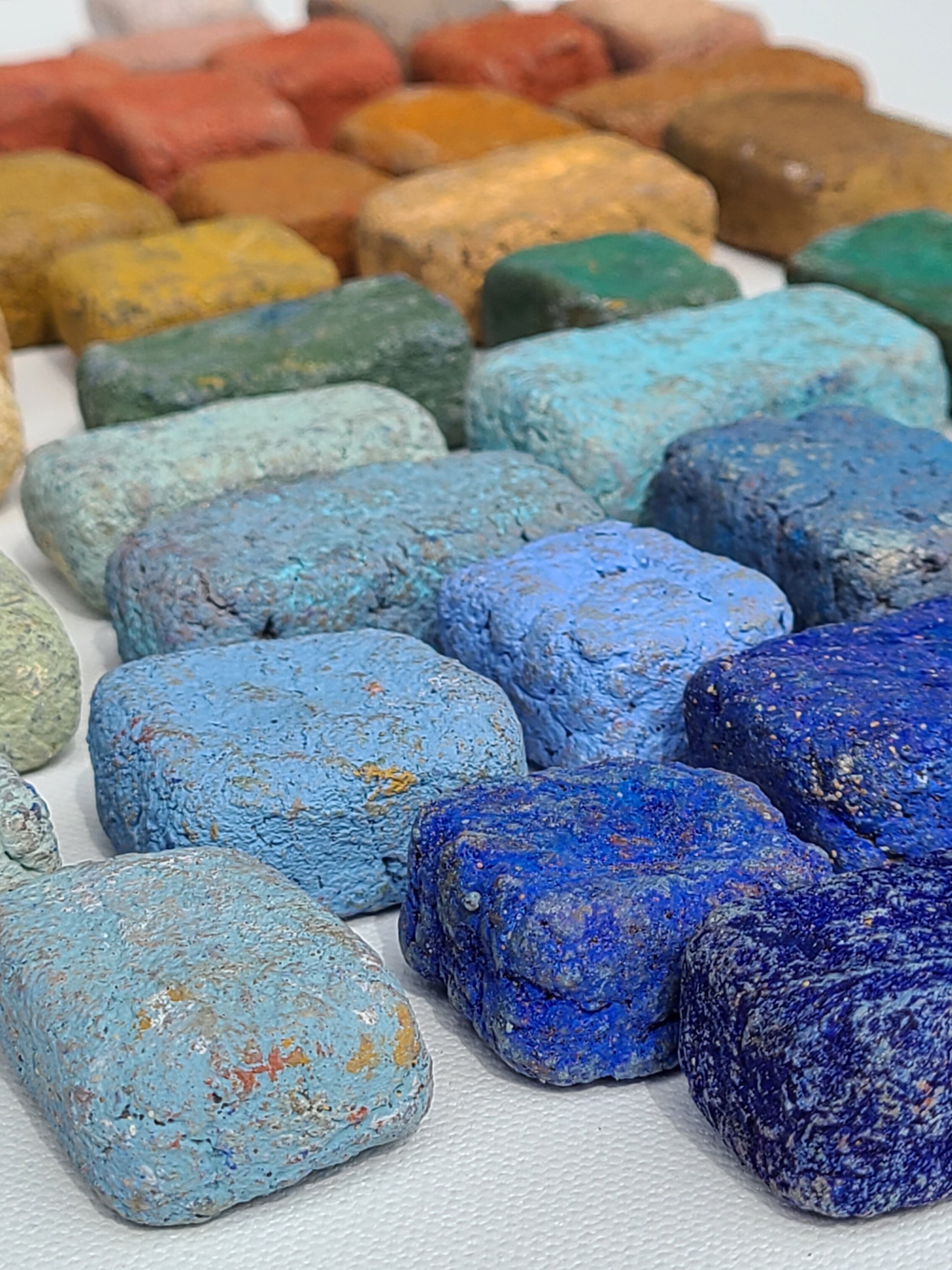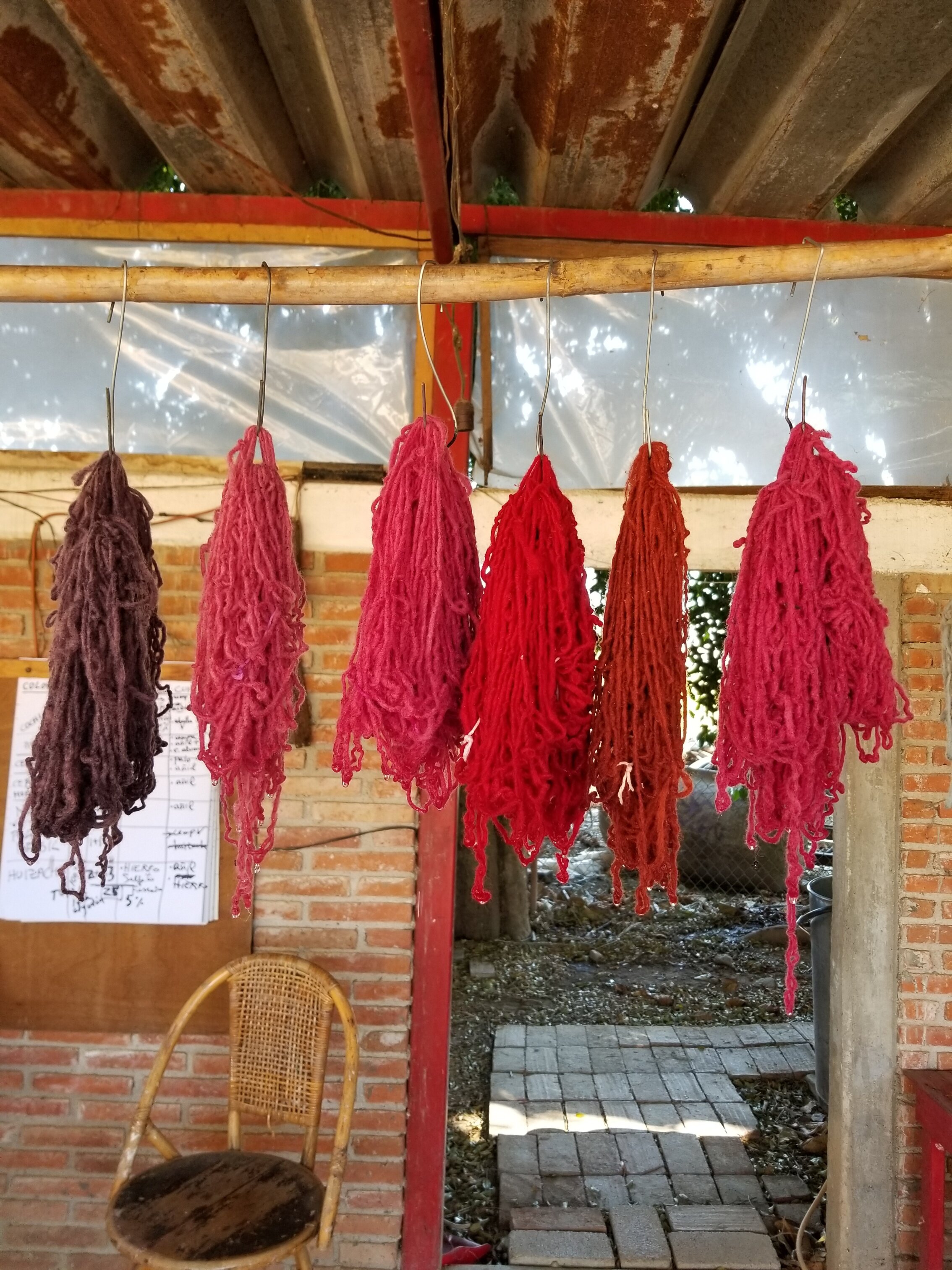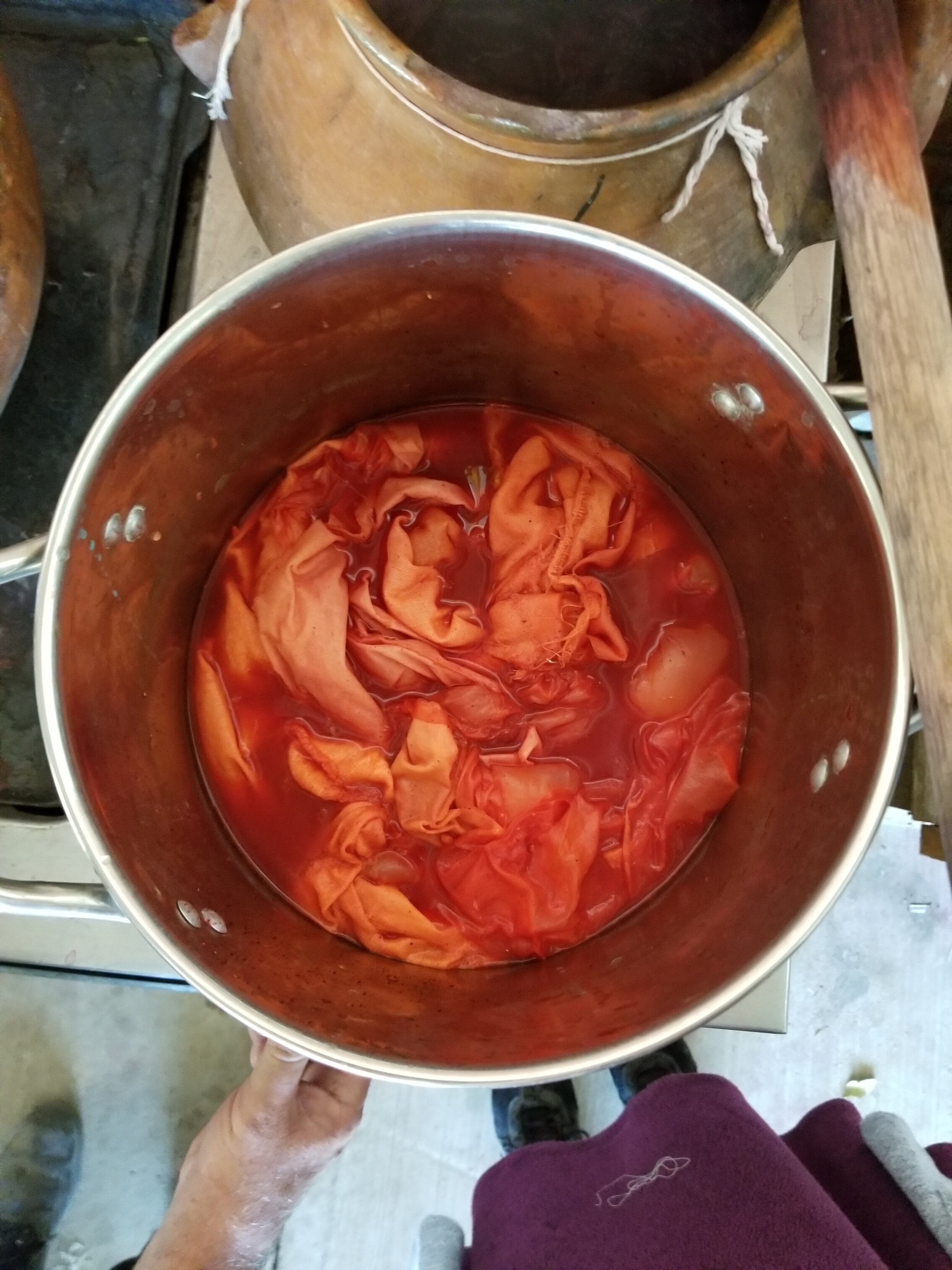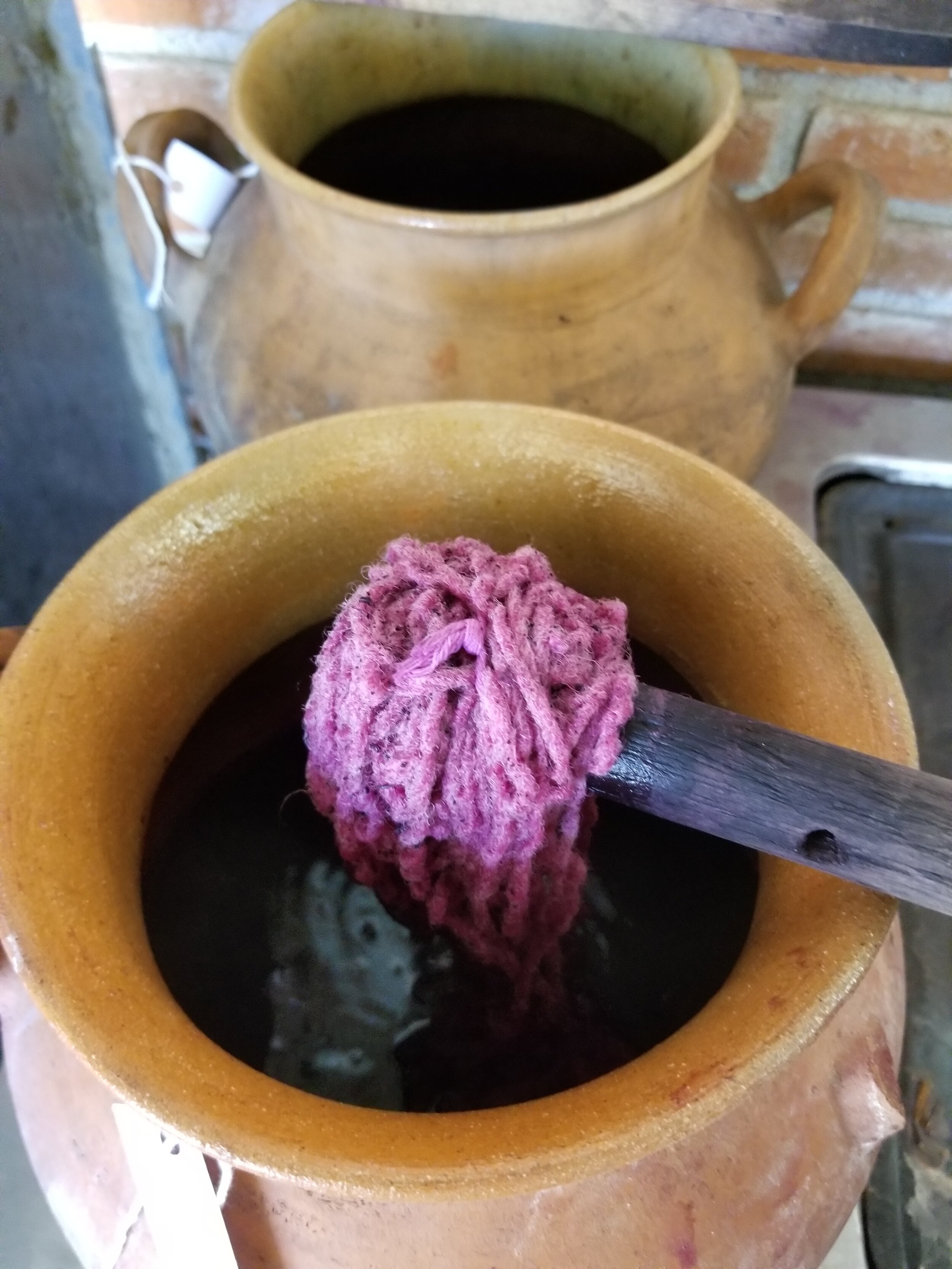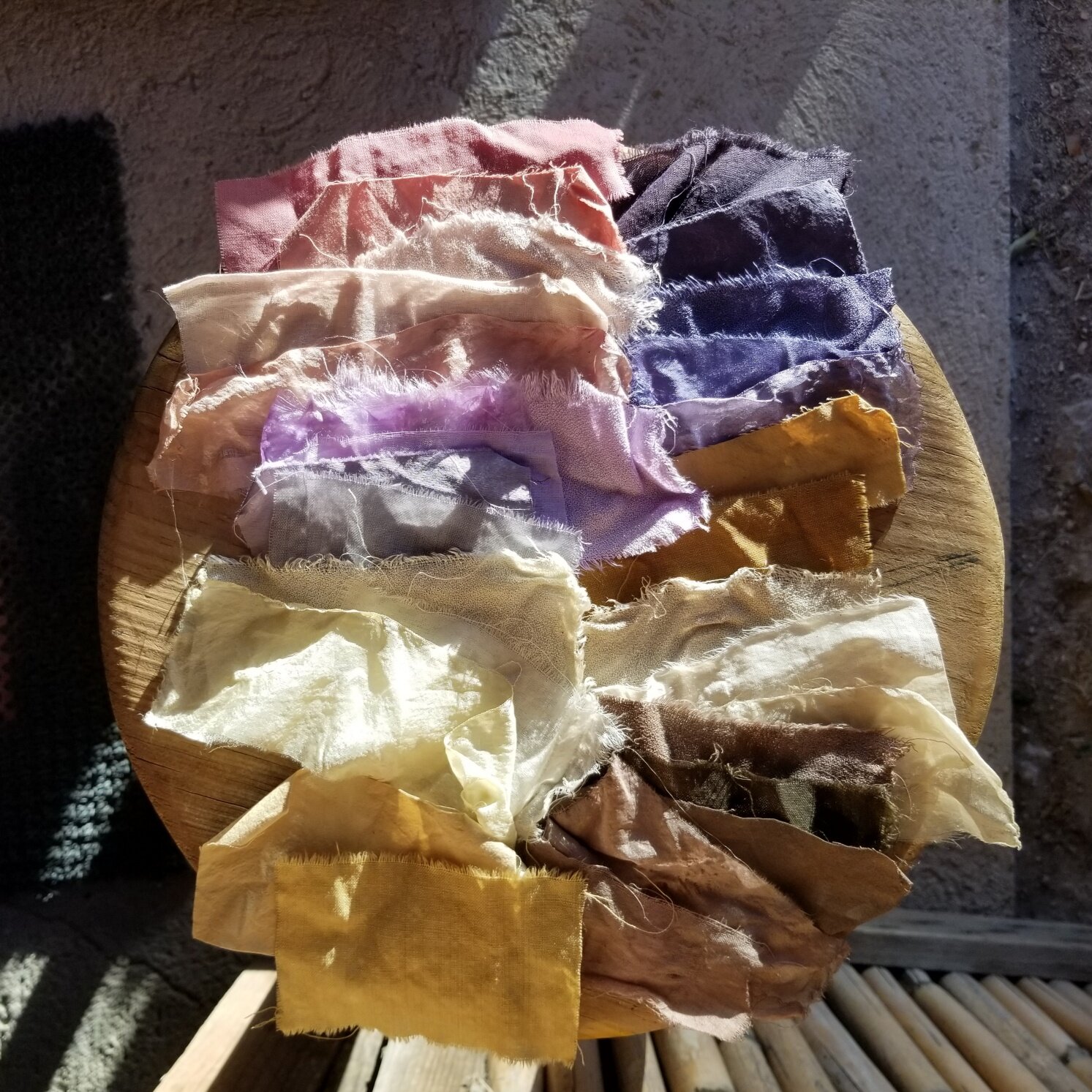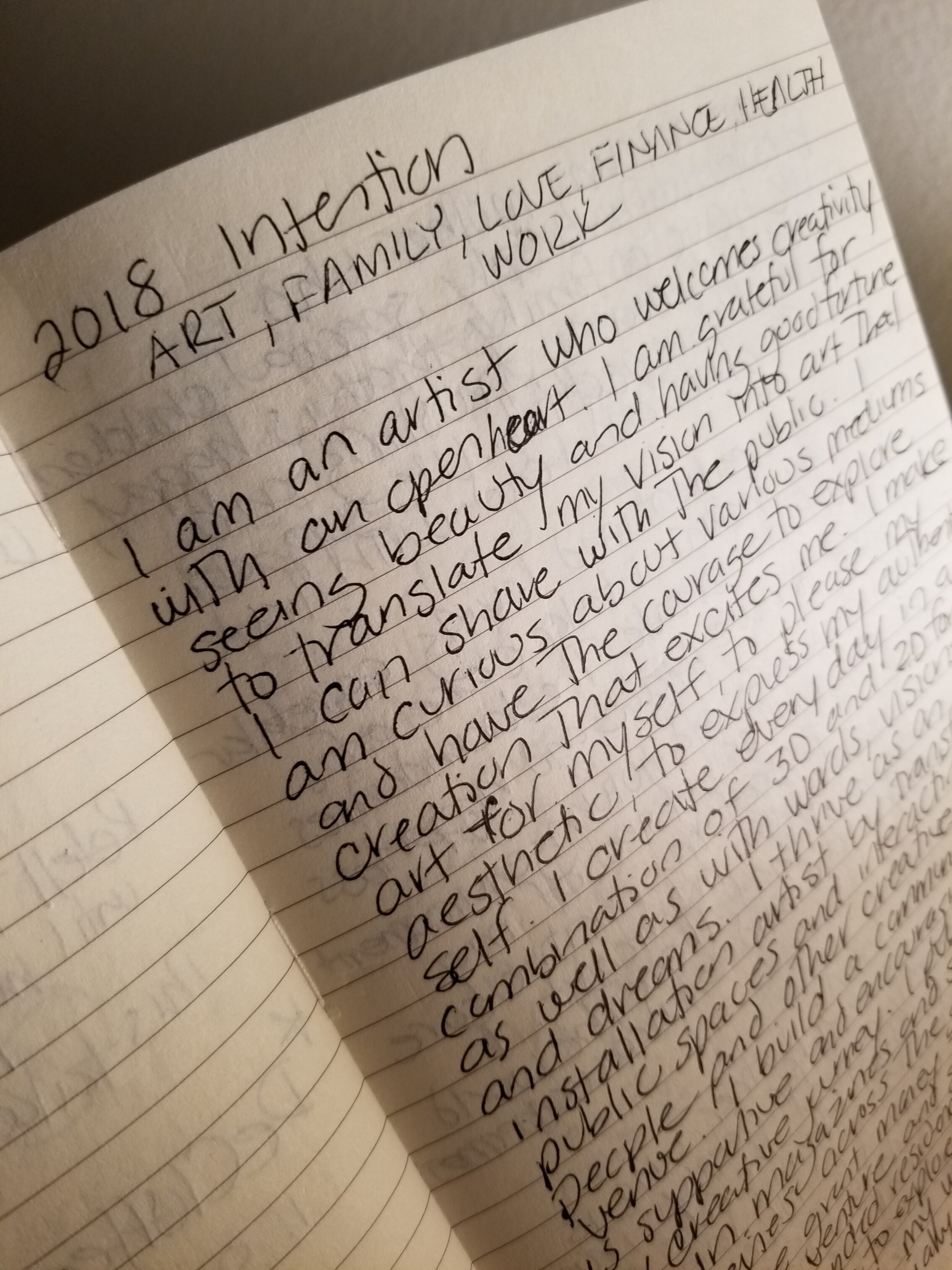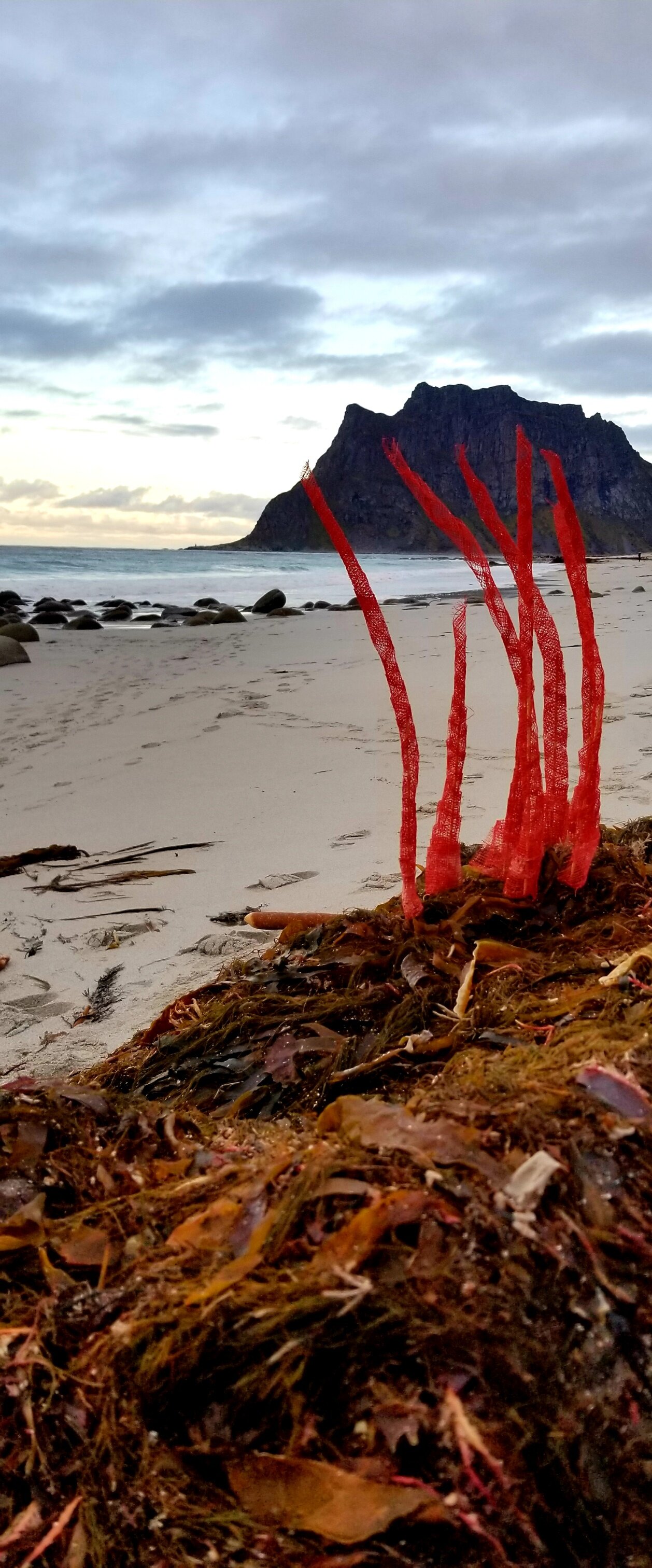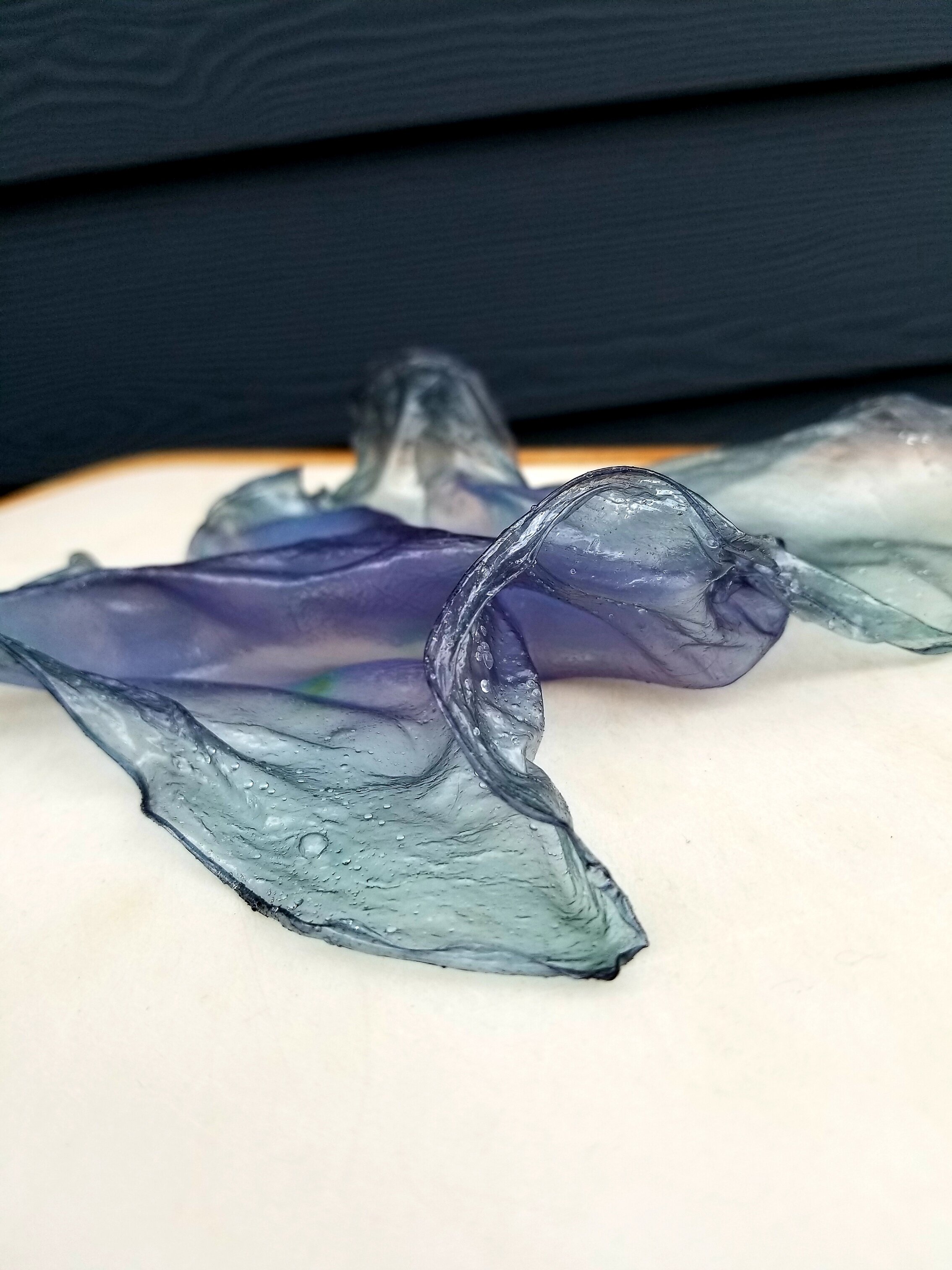Raking leaves in autumn is a perfect way to forage natural color right in your back yard. Japanese maple leaves create a pink/mauve dye for your textile and craft projects by simply chopping them up and throwing them in a pot of simmering water. Rich in tannin, the dye forms a strong bond with the textile that is long lasting and safe from light and water. This tutorial will show you how to forage and brew dye from Japanese maple leaves, as well as deepen the color with an iron water bath. You will see the resulting color swatch samples (cotton & silk) with various mordants.
Iron Water
Iron is a great way to shift your naturally dyed fiber to darker shades quickly and easily. Make your own homemade iron water with 3 simple ingredients: rusty nails, white vinegar and water. After a few weeks, your iron water is ready to go! You only need a splash, so store it away to use any time you are looking for darker shades including gray and black. This video tutorial will show you how to make and use iron water, as well as the resulting color swatch samples of 6 different natural dyes on cotton.
Cold pH Shift
You've seen how to shift the color of red cabbage in your dye pot from purple to pink & green, but did you know you can cold shift too? Grab red cabbage dye you already have stored and play around with the pH to see what different colors you can make. Temperature can also play a factor in the colors you achieve with natural dye. This video tutorial will show you how to quickly color shift your red cabbage dye with vinegar, lemon juice and baking soda, as well as the resulting color swatch samples (silk).
pH Shift
Red cabbage makes a gorgeous purple natural dye, but did you know it is also a color shifter? By changing the pH of the water with simple ingredients in your kitchen, red cabbage dye can turn to luscious pinks and vibrant greens. This tutorial will show you how to brew 4 different colors from red cabbage, as well as the resulting color swatch samples (cotton & silk) of all four dyes.
Red Cabbage
Red cabbage is a natural way to create purple dye for your textile and craft projects by simply chopping it up and throwing it in a pot of simmering water. The leftover 'soup' will be a vibrant dye that colors your fiber shades of lilac and lavender to deeper violet tones depending on your textile. This tutorial will show you how to brew dye from red cabbage, as well as the resulting color swatch samples (cotton & silk) with various mordants.
Black Bean
Black beans are a natural way to create blue dye for your textile and craft projects by using a cold process. Are you soaking black beans for a pot of soup? Fantastic - just let them soak an extra day and the thick leftover water can be saved for a blue that can have hints of green, purple and gray. This tutorial will show you how to create a 'cold brew' for a lovely blue dye, as well as the resulting color swatch samples (cotton & silk) with various mordants.
Spinach
Spinach is a natural way to create green dye for your textile and craft projects by using food from your kitchen or garden. Did you forget the spinach in the back of your fridge? Even better! Wilted leaves that are past their prime can help coax out that green dye. This tutorial will show you how to brew a subtle green dye, as well as the resulting color swatch samples (cotton & silk) with various mordants.
Citrus Peel
Citrus peel is a natural way to create yellow dye for your textile and craft projects by using your kitchen waste. Using citrus to add zest to your cooking or for a quick snack? If so, start collecting the skins to throw in your dye pot instead of your trash bin! Any citrus will work: grapefruit, orange, mandarin, lemon, etc. This tutorial will show you how to brew dye from the peels, as well as the resulting color swatch samples (cotton & silk) with various mordants.
Yellow Onion Skin
Yellow onion skin is a natural way to create orange dye for your textile and craft projects by using your kitchen waste. Start collecting skins when you use onion in your cooking instead of throwing them away. If you don't cook with onions, no problem! The produce department in your local grocery store will happily give you their skins if you ask for them. This tutorial will show you how to brew dye from the skins, as well as the resulting color swatch samples (cotton) with various mordants.
Hibiscus
Hibiscus is a natural way to create red and pink dyes for your textile and craft projects. If you don't live in a tropical area where hibiscus grows naturally, no problem! You can use hibiscus tea or dried flowers (see links below) for a quick and easy organic color alternative. This tutorial will show you how to brew dyes from both flowers and tea, as well as the resulting color swatch samples (cotton) of both methods.
Color Quest
Welcome to my new YouTube channel, Margaret Byrd:Color Quest as I move my Trail Tales blog to a vlog! Every Friday, I release new video content focused on the amazing world of natural color. Join me as I explore ways to forage and invite organic color into my creative practice.
Creative Currency
Whole numbers
I am now rich with sand dollars. Not the broken shells typically found in my childhood beach hunts, but perfectly whole specimens of this sea urchin treasure.
Seriously – we are talking the mother lode of sand dollars.
Never have I seen such a gorgeous array of sizes and colors of whole sand dollars washed up on the beach, Cayucos, California, September 2020.
So, what does an artist do with so much natural wealth?
Simple – leave it behind in exchange for creative inspiration that only the coast can generously offer.
Welcome to California’s Central Coast!
Bank holiday
My latest journey to visit my daughters living in San Luis Obispo filled my pockets up in more ways than one.
Christmas was the last time I saw my oldest daughter, Devon, and the pandemic had cancelled a springtime trip to play on the beach with all four of us together.
So, two weeks relaxing oceanside with my kids this past month was a true gift.
Hiking Harmony Headlands with my kids, Zsofi, Devon and Mason, August 2020. So much fun!
Exploring the sea cliffs at Montaña de Oro and Harmony Headlands state parks, watching my girls surf at Dog Beach and Moonstone, and catching some pretty sweet sunsets brought some big smiles.
Devon living the surfer’s life on Dog Beach in Cayucos, California, September 2020.
Zsofi shredding it on a foggy day at Moonstone Beach, Cambria, California, August 2020.
It also brought me the opportunity to connect more deeply with my surroundings by leaving small installation offerings as an ephemeral payment of gratitude.
Thank you, Central Coast.
Frozen assets
To tender ice as an artistic medium on a windy beach is exciting stuff.
Finding the perfect spot to create a brief visual experience involves sand, stone and surf. And, as you might imagine, not all places freely accept my form of creative currency.
You have to place a lot of ice to get a lucky shot, and luckily, the failures melt fast! Moonstone Beach, Cambria, California, September 2020.
But, failed attempts are all part of the trek, and without the stagger there can be no sparkle.
Ice installation is a true balancing act of patience and persistence. Cayucos Beach, California, August 2020.
All of the rejected installations are rewarded with laughter and lessons of letting go - critical elements of building a balanced artistic practice.
Bag of sand
Two beaches that are especially generous in their inspirational exchange along the Central Coast are the pebbly Moonstone and the long sandy strand stretching from Morro Bay to Cayucos. Although waves crash against both to sculpt the tideline, there are unique features at each one that draw me in time and time again.
MOONSTONE
Say hello to a rock hound’s paradise of agates, jade and jasper. Every visit I make to the area requires a few hours simply sifting through the stones. So, leaving a small ice installation to mimic the colors of the tumbled rocks felt perfectly placed.
Blue butterfly pea, hibiscus, spirulina and turmeric created beautifully vibrant ice sticks to complement the colorful stones on Moonstone Beach, Cambria, California, September 2020.
Ice orbs mixing with the salty spray of Moonstone Beach honeycomb rocks, Cambria, California, September 2020.
The wind whipped hard on the beach that day, adding to the expressive challenges, but my incredible kids stuck by my side (behind a driftwood shield!) so their free-spirited mom could artfully play.
Love you guys!
CAYUCOS
While this beach charmed me with its trove of whole sand dollars, it was the long, slow tide and larger rock outcrops that inspired my icy installations.
The proximity to our house made it an especially great space to experiment with frozen shapes across several days and in different light.
As the tide stretched in and out, tidal pools exposed vibrant sea anemones and their starfish friends.
The neon glow of the sea anemone at low tide was breathtaking, Cayucos Beach, California, September 2020.
The variation of barnacle formations and mussels on the exposed rocks created intriguing complements to the melting blue cylinders of ice.
Perhaps the most compelling geological feature was a sea stack that brought back memories of an installation adventure in Lofoten, Norway in 2018.
Granite Stack ice installation in Lofoten, Norway is one of my very favorite shots, October 2018.
I made several attempts to capture the essence of Granite Stack, and was treated to a special image in exchange for hours quietly washed away by the California tide.
Mussel Stack ice installation in honor of Granite Stack, Cayucos Beach, California, September 2020.
Stack ‘em deep
Seems that my creative reserves have been happily refilled by my time on the Central Coast, and for that I’m thankful.
The rush of excitement I felt by collecting fistfuls of sand dollars was immediately followed by a natural impulse to interact with their subtle beauty.
Sorting, stacking and releasing them back to the sea is somehow intertwined with the curiosity that drives my installation practice.
How comforting to know I can bank on this coastal inspiration forever.
The Art of Craft
Small craft advisory
As an artist, I aspire to be crafty.
Forget the misguided, and tragically oppressive Western narrative of ‘high art’ as somehow ‘enlightened’ and more valuable than the exquisite beauty found across all creative expression labeled as ‘craft’.
If you can translate an idea from mind to hand, the material is immaterial – you are an artist - plain and simple.
My creative curiosity has led me down a crafty path or two, and I’m now enamored with one diversion so often associated with handiwork: natural dyeing.
Some of my kitchen favorites for natural dye: avocado, turmeric, red cabbage and black bean.
While I could fight against the notion that this diminishes the value of my art, why would I entertain such a silly thought?
Nope. I choose to celebrate, my artist friends, so let’s get crafting with natural color!
Color classics
Focusing on colors from nature in #The100DayProject has filled my fridge with an incredible rainbow of botanical dyes.
Dyes brewed from foraged plants and food scraps during #The100DayProject.
Every time I find a new plant to brew, I add to my collection. When I see a color missing, I go searching for a plant. It is a never-ending exploratory cycle.
10 dye plants foraged from Tambark Park and my garden waste to study local flora colors.
As I shared my project, and the art I created with these dyes, I could hear the buzz all around me as people became curious themselves. Certainly interested, and maybe even inspired, to learn about natural dyes.
I get this. I have a history of being intrigued myself. It’s how this passion for organic color grew and how I learned what I know so far. Ironically, it seems the more you know, the more you want to know.
Having had many of the same questions when I started my love affair with nature’s palette in 2017, I have been searching high and low for answers ever since.
When I learned from a Dutch artist that seaweed was a sustainable source of dye, I headed to Iceland to investigate.
And, because sharing is caring, I’m very excited to tell you a secret I’ve been keeping all to myself:
Starting in August 2020, I will be releasing short tutorial videos and mini-courses all about the incredible world of natural color. My intention is to build a place where you can easily find the basics to get you inspired to add color to your life naturally.
Soon to be released YouTube channel, Cookin’ Color, with short video tutorials on organic dyes, August 2020.
The topic is HUGE. There are so many options and different approaches to extracting color, plus a multitude of ways to use it.
For me, organic color has been an integral part of my installation practice, and more recently my mixed media work. But a beautiful aspect of natural color is that it is available to everyone, no matter where you consider yourself on the art/craft spectrum.
Bioplastics cooked and cured with natural dyes in my kitchen studio in June 2020.
And, the botanical dye in my fridge right now is a perfect example of the countless ways we can weave natural color into almost everything.
Nature’s bounty
Finding a way to create color in an ephemeral installation without hurting an environment is how I got hooked on natural dyes. But as my #100DaysOfNaturesColors meandered its way through botanical dyes and earth pigments, I could clearly see just how many different ways I have been exploring color from nature. Maybe one or more of these will strike a creative chord with you too!
TEXTILE
Probably the most obvious and popular use of natural dyes is to create sumptuous hues for fabric. With a growing interest of sustainability in fashion, botanical colors are popping up from head to toe. If you’ve got natural fibers in your closet (cotton, hemp, silk, wool), you can dye organically – the options are endless.
Textiles of wool, silk, cotton and bamboo hand-dyed in Oaxaca exclusively with organic matter.
My first on-line workshop will be on how to create an ombre-dyed scarf from foods in your kitchen, and this fall, I will be teaching a similar technique using earth pigments. Incorporating these rich colors into a wardrobe is a delicious way to get your art out of the house.
However, if knitting or weaving is more your speed, soaking yarn, string or ribbon in a batch of botanicals can create subtle sweetness. Just look at the wonder of this wool I dyed in Mexico.
Wood hand-dyed in organic matter including indigo, muicle, pericon and cochineal in Oaxaca, Mexico.
While I preferred to use this fiber for installation, imagine a hat, scarf, mittens or sweater with that special colorful touch?
But who says you have to wear hand-dyed textiles? My mom was an avid quilter which I’m certain has influenced my mixed media textile pieces and love of squares.
Naturally dyed textile piece, Blossom, created while on residency in Oaxaca, Mexico, March 2020.
How special it would have been to forage with my mom and organically dye fabric swatches for her to sew into her quilt creations. Keep that in mind for the quilters in your life.
PAPER
Textile’s extended fiber family is paper. The delicate translucency of paper has intrigued me for quite some time, both for sculptural and 2D applications. In Oaxaca, I first tested how wet strength fibers like mulberry and tissue would hold the colors I had brewed, and it worked like a charm.
First time hand-dyeing paper with plant matter in Oaxaca, Mexico, March 2020.
So, one chunk of 10 days during #The100DayProject, I focused on creating collage with these dyed papers. The variations of color, especially when layering, felt closely tied to the depth I love to create with overlays of silk in my textile pieces.
Hand-dyed paper collage backlit in Tambark Park, made exclusively from organic dyes foraged in Oaxaca, Mexico.
Feeling inspired, I foraged local ‘weeds’ in my beloved Tambark Park the last 10 days of the project and made a new rainbow stock of colorful paper from the PNW.
Paper samples of natural dyes brewed from foraged plants in my neighborhood. Only blue butterfly pea was from my kitchen!
What’s wonderful about paper is its versatility across several art disciplines, and a true staple in many craft projects. Why not make hand-dyed paper with plants foraged from your neighborhood the next time the scissors and glue need some exercise?
INK
Dyeing paper is one way to spread some of nature’s colors around, but making ink turns just about any organic matter into a medium for drawing and watercolor fun.
I simply poured the dyes I brewed from foraged plants in Iceland and Mexico on paper, but learning how to make ink specifically was yet another way to expand my natural color wheel during the last 100 days.
Testing inks made from avocado skin and red cabbage during #The100DayProject.
I even made blue ink with my cherished blue butterfly pea blossoms for the first time, one of the most elusive colors of nature.
Watch out - lake pigments might be just around the next corner!
KITCHEN KRAFT
While all of the above may result in time at a craft table, a stovetop is still a critical element in a studio of natural dyes. Therefore, it’s no surprise that crafts of the kitchen can also add a splash of organic color.
Much of my installation work was born in the kitchen - infused ice, mung bean and playdough have been some of my edible shining stars.
Mung bean string installation naturally dyed with kitchen scraps in Sayulita, Mexico, December 2018.
Brewing organic dyes as natural food coloring for baking, cooking and blended drinks is certainly a fun way to add color in the kitchen. At the very least, you can start with next year’s Easter eggs having that natural color vibe.
This year’s Easter Eggs were dyed au naturel in turmeric, red beet, red cabbage, avocado and blue butterfly pea.
Plus, the kitchen is the perfect place to start playing with natural dyes in general. So many fruits/veggies, spices and even food scraps can make wonderful colors with very simple recipes.
In case you missed it this spring, download a copy of my Cookin’ Color brew booklet with a few of my favorite kitchen dye recipes, or better yet, sign up here for my 5 Days of Dye short video tutorial series releasing soon in a kitchen near you!
HEADING
Go ahead – call me crafty. I don’t mind at all.
To be honest, I question why any negative association became attached to a word that honors the vision and skill it takes to create beauty with your hands. To be an accomplished craftsperson is a lofty goal for any artist, and certainly one I aim for in my daily practice.
So, let’s keep spreading the art of craft in the world today!
The Tambark Ten
Frozen
The itch to travel runs deep in my veins. Funny enough, I’m also strangely content to hole up in my home for long stretches of time. Perhaps the balance for me is having an alternating pulse of movement and stillness.
With travel at a standstill, walking has become my movement of choice this spring, and as luck would have it, a small forested land sits opposite my house – Tambark Park. Daily excursions into the lush greenery spurred inspiration that translated into a surprisingly abundant creative surge starring two of my art darlings: ice and installation.
Shot glass ice installations popping up all over the place!
Boy, have I missed you two!
100 steps
Heading into the fourth 10-day chapter in #The100DayProject, I committed to placing installation right outside my front door. Until now, I had connected my installation practice solely to the exploration of distant lands – a way for me to personally interact with a landscape that provided wonder and inspiration.
One of many ice installations inspired by the breathtaking beauty of Iceland, December 2017.
You don’t have to go far in the PNW to have this sensory experience of marvel. Slowing down and opening up to my local surroundings brought me simple joy, loads of chuckles and some pretty sweet photos.
Organic dyes of avocado, turmeric and red cabbage melting in all their glory.
Let’s meander through these 10 days together.
Spark
Full disclosure - I stole the idea to place installation in Tambark Park.
As the world shut down in March, a beautiful trend of leaving small gifts of love and hope emerged. Walking the trails, I started noticing flowering plants that were not indigenous to the undergrowth.
Did forest elves plant these colorful treats amongst the cedars?
It took the brightly colored blooms at the base of several looming evergreens to notice a pattern: Someone was planting these in the darkest corners of the forest to offer light.
Another sweet offering scattered across the property were colorfully painted rocks. Spying the hidden stones became a visual treasure hunt I looked forward to playing every day.
Some of the painted treasures even had messages of hope.
These acts of kindness poked at my creativity, and so bloomed 10 days of installation.
Icy roads
Colors from nature first appeared in my art as a non-toxic way to tint the ice pieces I placed in Iceland in 2017 – the launching point for my installation practice.
Winter sunset through blue butterfly pea and red cabbage in the Westfjords of Iceland, December 2017.
Frozen climates eventually graduated to balmy locations to push the limits of ice as an ephemeral medium.
From tiny rental refrigerators to mobile coolers meant for chilling wine and travel snacks, I froze all kinds of shapes and sizes of water infused with plant-based organic dyes I brewed. I took some crazy pride in the lengths I went to transport my frozen works of art to their installation destination.
The ice cooler is a must-have on installation road trips, Maui June 2018.
Ice was an obvious choice for Tambark Park to stay true to my project of #100DaysOfNaturalColor. And to be honest, I never had it so easy! Using my full-sized freezer, packing a thermal lunch bag and walking no more than 10 minutes to place installation was an absolute dream.
The beauty of ombre dyes frozen in a full size freezer is pure magic.
Note to self: it doesn’t always have to be so difficult!
Secret garden
Tambark Park has a network of trails that meander through a mixed woodland. The search for more pristine locations, however, had me traipsing off the beaten path where I found some amazing nooks and crannies in the greenery.
Ice stack placed where few have ventured except for fallen trees.
I may have been only 20 feet from the footpath I walked every day, but it transported me back to the days of my childhood where we spent muggy summer days hunting for hidden places in the brush to build forts and play hide-n-seek.
Bumping into fellow hikers in Tambark Park while reemerging from the secret spaces always garnered a curious look and sometimes even a smile.
The green light
Blazing my way through the thicket meant I stumbled into some of the PNW iconic vegetation: erupting ferns, fuzzy tufts of moss, horsetail reed and skunk cabbage. Such variations of green allowed for creative play that produced a visual tension with the vivid colors of the frozen botanical dyes.
A colorful shoot of ice in the midst of fern fronds.
The woody stumps of fallen trees provided sumptuous textures in a wonderfully neutral palette that also allowed the ice to shine.
Ice marbles wedged into weathered wood.
Possibly the second most exciting discovery was bumping into stinging nettles. Yes, they left their painful mark on my hand, but without this accidental collision, I would not have been able to identify this weedy herb.
The stinging nettle that bit me during installation will be a welcome addition to my dye pot.
Soon I will head back to collect the leaves because they make the most incredible gray-green dye, a color not easy to find in nature ironically.
Creature comfort
And what would the flora be without the fauna? Hiding among all of this incredible foliage, I was treated to chance encounters with all kinds of animals:
Rabbits flourish here and spring is the time of baby bunnies.
One lone squirrel would rustle in the trees in the same spot almost every day
A bat swooshed just above my head on a twilight installation.
Even a snake slithered its way across my path!
But, the ultimate treat, and yes, THE MOST exciting discovery was a tiny friend who joined me on the very first installation.
The first ice installation in Tambark Park had an unexpected spectator (see below photo).
Thanks to patiently waiting for the streams of sunlight to hit just the right spot, I was lucky enough to catch a glimpse, and a photo, of this sweet tree frog.
The tree frog who sat quietly for more than an hour while I placed ice and returned to its melted remains.
She didn’t dash away, and even when I returned an hour later to check on the ice melt, she was still cozy in her hole, taking in the afternoon rays.
Ice flow
Where there are frogs, there is water, and Tambark Park has a lowland marshy vibe trickling everywhere. Many a day was spent mucking through spongey ground to install, but I also examined how a stream’s gentle current would dance with my ice pieces.
Mother’s Day ice installation in honor of my mom, Maia, who passed away May 31, 2019.
I’ve played with kinetic energy in my installation work, and certainly the simple act of melting is an inherent trait of mobility in ice.
However, running water provided many more layers of movement to explore: Releasing, floating, bobbing, flowing, dissolving, and ultimately, disappearing.
Frozen floats of organic dyes in Tambark Creek gone within minutes of placing this installation.
Movement, in fact, may be implicit in the ephemeral – an idea I am just now realizing.
Micro-living
Ten tiny days of micro-travel has had a macro-impact on a deeper understanding of my creative practice. Slowing down to open the senses to my immediate surroundings has brought wide open space for reflection. Yet again, I’m reminded that movement can be a collective effort of small steps, as long as I actively nurture its momentum.
10x10
Natural order
I’m a big fan of squares in my art.
To be more accurate, I should probably broaden that statement to say ‘I love parallelograms’ because rectangles and rhombi pop into my artwork as well. Since a square is a kind of rectangle and rhombus, but neither a rectangle nor a rhombus is necessarily a square, I may want to be more inclusive of the linear shapes that have inspired me for decades.
All kinds of naturally dyed parallelograms playing on this canvas!
Side note: Can you tell that I’ve been tutoring my son, Mason, in geometry this spring?
So, as I sat down to write this month’s Trail Tale to share my journey into #The100DayProject, I realized I was playing with squares again. Only this time, in an algebraic way: 10x10=100, or more simply written 10².
Projection
When mixed media artist, Natalie Dadamio, suggested I try #The100DayProject this year, I thought it would be a fantastic way to deepen my commitment to my creative practice. Knowing I would be grounded from travel, at least of the air variety, diving into 100 days of a focused art ‘project’ seemed like a wonderful way to enrich the time in my home studio.
We used to have a kitchen island, but that real estate is now gone, along with the dining room table.
But why 100 days, and how would this differ from the extensive hours in the ‘off-hours’ that I’ve already heavily invested in this crazy creative biz dream of mine?
Seems the consensus is as follows on the power of 100 days of focus:
It is long enough to create a habit
It is short enough to see the finish line
It requires setting an achievable goal
It demands planning to allocate time and space
It is extremely helpful to break it up into manageable micro-steps
Coincidentally, three of my 2020 goals are hovering right now in the 100 day range. Making healthy nutrition choices, increasing movement and meditating have become daily habits. Ways of living that seemed to elude me throughout the years are wonderfully entrenched in my world today.
And, I’m at least 10x10 times happier.
All smiles on the cochineal farm in Oaxaca, Mexico, March 2020.
100 days of art….bring it on!
Hash it out
First thing first was to decide what my 100 Day Project focus would be. As you may have noticed, I suffer from a kind of creative distraction disorder. My artwork crosses all kinds of discipline and medium lines as my curiosity drags me from one to another and back again.
So, how was I to choose just one of my many passions?
Easy: #100DaysOfMultiPassion
But, in an effort to corral those multi-passions of mine into a more cohesive project, I needed a theme.
One idea came to me naturally: #100DaysOfColorsFromNature
The rainbow of mineral pigments I foraged while on residency in Oaxaca, Mexico, March 2020.
Now, with not one, but two hashtags declaring my project, there was one tiny manageable micro-step I had to take.
Breaking it all down by 10.
Chunky monkey
As I hit publish on this blog, I’m about to celebrate my 25th day – one quarter done! For those of you following my adventures on Instagram, you have had a preview of where these 100 days are meandering. For those of you on Facebook – sorry!
Breaking the project down into 10 days each of 10 different ‘topics’ surrounding natural color felt like the perfect solution to keep me on task. Plus, I argued, it would allow me to truly explore all of the ways nature’s palette has inspired my art.
Pigment color studies from the regions of Peru where we explored and foraged in June/July 2019.
If you’ve read this far, you are in for a sneak peek of the full 10x10 plan. Plus, I’ll throw in a little commentary and few more photos of chunks 1 and 2 (Days 1-20) which have already flown by:
Days 1-10: Natural dyes
I may have started using organic colors in ice, but the list of materials I have dyed from nature also include textile, paper, bioplastics and even eggs. I may have left out mung bean and dough in this project, but I added a new piece to the dye mix – ink!
Cookin’ colors in the kitchen to make inks from red cabbage, black bean, avocado skins and turmeric.
Days 11-20: Mineral pigments
Over the past 1.5 years, I widened my color scope to include the earth beneath my traveling feet. Each day, I shared some of the subtle hues I foraged from 7 unique locations: Washington, Idaho, Oregon and California on the west coast, Pennsylvania to the east and Mexico and Peru to the south.
Pigmented stones foraged along Wissahickon Creek in Philadelphia, PA, July 2019.
Days 21-30: Textile colors
I’m midstream in the 3rd chunk and creation is underway. Every day I’m building a quick color study with textile remnants I have collected from larger pieces I built in Oaxaca. The idea is to push the design from a limited natural palette in a small space.
Textile Stack Series of quick color studies during #The100DayProject. Drop me a line to purchase.
If you want a piece of the action, each one of these mixed media works on canvas is for sale at $40.
What a steal of a deal!
Now the next 7 chunks are part of the plan, but I reserve the right to make adjustments along the way:
Days 31-40: Installation – I will place 10 new naturally colored sculpture clusters within 0.5 miles of my house.
Days 41-50: Oaxaca Minis – I will build 10 new 8x8 textile works on canvas from the full Oaxaca color range.
Days 51-60: Bioplastics – I will brew up all kinds of wonder with gelatin, algae and botanical dyes.
Translucency and botanical dyes all wrapped up in bioplastics.
Days 61-70: Monoprints – I’ve wanted to explore this technique, so I plan to create 10 pieces using only natural colors.
Days 71-80: Three shape challenge - Textile
Days 81-90: Three shape challenge - Monoprint
Days 91-100: Three shape challenge: Installation
Let’s just say the last 3 chunks are meant to hold my feet to the ‘simplicity’ fire.
The same artist who enticed me to join #The100DayProject (Natalie Dadamio), also challenged me to ONLY use three shapes in my work during the 100 days. I figured 3 chunks totaling 30 days fit perfectly into the 3 shapes theme.
The 3 primary colors very cooly represented by turmeric, red beet and blue butterfly pea infused ice.
These three are for you, Natalie!
Cubism
Riding shotgun to my 100 days, Mason has found a teeny space for his geometry book on the dining table that is now smack dab in the middle of my studio, aka our kitchen.
We started solving for volume this past week. All of the 2 dimensional shapes have introduced their 3 dimensional siblings: spheres, cones, pyramids and cylinders.
And yes, the glorious square is full of pride and flaunting its cube cousin just to make me smile!
My trusty installation travel buddies: earth pigment painted paper pulp blocks. Stack ‘em up!
I sure do love cubes…naturally.
The colorful Mr. Biv
The stuff of rainbows
Don’t know about you, but I have a handful of tricks up my sleeve to remember trivial bits of information. I am the maven of mnemonics:
Need to know how many days there are in April? Got my knuckles for that.
That 5 letter Great Lake messing up your crossword puzzle? Try H.O.M.E.S. on for size.
Pulling out the crayons to draw your sweetheart a rainbow? I’d like you to meet Mr. Roy G. Biv
I think it was my grade school art teacher, Mr. Malley, who taught us how to remember the seven colors of the rainbow. (Yes, I had a full time art teacher with a dedicated art room when I was a kid!).
Mr. Biv has been a tool in my paint caddy ever since.
The organic colors of the rainbow hand-dyed on paper in my residency studio in Oaxaca, Mexico.
So, of course, Mr. Biv was my travel companion to my artist residency in Oaxaca, Mexico, last month as I continued my quest to find the rainbow in nature’s palette. Let’s just say, we found all seven of his colorful letters and then some!
Red
The color of love (among many other things) is a highly sought after hue that has a history connected to imperialism and revolution. Minerals of hematite and cinnabar, the root of madder and several parasitic creatures have been foraged and crushed so we can bathe in red.
One insect in particular has become the darling in the wide world of dye: cochineal.
I had only bumped into cochineal about a year ago when I was preparing for my residency in Iceland. Visiting a dye master in the countryside two hours north of Reykjavik, Guðrún Bjarnadóttir shared the secret sauce of her scarlet wool yarn.
The gorgeous hand-dyed Icelandic wool of Hespa Iceland. Looks like a neutral cochineal soak to me with those bright fuchsias peeking through.
She had a large jar of cochineal that she imported to Iceland as her ancestors had done before. You see, red and its variations are not natural colors found in Iceland.
Cochineal is a parasite that lives on the nopales cactus indigenous to present day Mexico and Peru.
The white powder of the cochineal insect dusting nopales cacti before harvest.
Contrary to what you may think, the red comes from carminic acid, not blood, which acts as a deterrent against predators. Or, if you are human, it seems you are wildly attracted to it!
Working for three weeks on a cochineal farm in Santa Maria Colotepec in Oaxaca, Mexico, the secrets of its beauty were slowly revealed to me.
All the lovely shades of cochineal hanging out in wool yarn on the farm near Oaxaca, Mexico.
But, not only did this tiny insect produce the most amazing carmine color, it played a starring role in many of Mr. Biv’s letters.
Orange
Beyond the measurements I wrote about in last month’s Trail Tale, dyeing incorporates some elements of chemistry.
Who remembers those little litmus strips from your high school lab? Well, turns out cochineal is sensitive to the pH level in the dye bath. Add a bunch of lemon juice, aka. acid, and mira - orange!
Shifting cochineal neutral by squeezing lemons. The secret of playing with pH!
Makes me chuckle to think that adding yellow to red actually makes orange in this corner of the dye world. Trust me, that isn’t a hard and fast rule in dye chemistry, but cochineal happily plays along.
Yellow
I know what you’re thinking: lemon juice must be a key ingredient in yellow dye. Nope. I have recently seen Sasha Duerr, a natural dye specialist, create yellow from citrus skins, but in Oaxaca, we used pericon.
You may know this native herb as Mexican tarragon or marigold, both of which are used as dye in other parts of the world. The pericon grown and harvested on the cochineal farm, however, produced a gloriously vibrant yellow that demanded visual attention.
The green leaves of pericon cooking up some instense yellow on silk strips I used for installation in Oaxaca.
Move over marigold – you may have a rival nipping at your heels, but pericon may be tough to find in my local PNW nursery.
Green
When it comes to the plant world, it’s not easy being green.
Both, Guðrún Bjarnadóttir and Manuel, my Oaxacan dye master, utilize the primary color theory to achieve green. First you dye with yellow (pericon or another yellow source), and then you over-dye with blue (indigo), another elusive color rarely found in nature. Voila - green!
Although I attempted this on the farm with my wool yarn samples, I struggled with the indigo (more on that below). That didn’t stop me from experimenting in my own dye studio on days away from the farm, and I had some success.
Who knew the cold sludge of fermenting black beans could tease out such gorgeous greens?
No over-dye step required here. Just a 2 day cold soak in fermented black beans!
I was expecting a grayish blue dye result when I bought the dried beans in the Mercado 20 de Noviembre. You just never know with natural dye - the surprise element is one of its sweetest characteristics.
Blue
If you think red is tough, you haven’t met blue yet. Treasured minerals of lapis lazuli and azurite are pigments of royalty. In the plant kingdom, indigo is queen.
The cochineal farm is an educational venue exclusively focused on the natural dyes of the region, and indigo has roots in the tropical climate of the Oaxacan coastline. Manuel grows every plant we used on the farm, but his indigo suffers in the dry heat. So, as traders have done for centuries, Manuel brings his indigo crystals from the coast.
Grinding indigo with mortar and pestle before adding it to the dye pot.
Extracting color from indigo is a labor intensive process and one that requires humility and reverence. I was quickly humbled by the mystery of blue.
Indigo
With all the work that went into making 12 dye pots to create 40 unique colors over three weeks, saving indigo for last didn’t surprise me. However, I soon realized that rushing indigo at the end did not honor its spirit, and so it did not fully share its color with me.
The many shades of indigo from an ignored dye pot hanging out with no-fuss cochineal orange.
When I explained how tough my day with indigo had been, a local artist told me the secret of the blue goddess: one must be fully present without distraction or haste.
I love this thought. It rings true across so many aspects of life, and so now indigo is yet another gentle reminder of the beauty of presence.
Violet
The last letter in Mr. Biv’s name was a dual effort in the organic realm. That sneaky, chameleon of a dye, cochineal, can be shifted to a yummy color of the violet persuasion. All the alchemist has to do is sprinkle in minerals (various recipe options) which can shift the pH balance to alter the hue.
Cochineal neutral plus 15% alum working its violet magic!
No minerals to be had – no problem: muicle to the rescue! Picking the leaves of this medicinal shrub on the farm produced a lovely violet dye as well. I doubt these leaves are sold in my local farmer’s market, so they may be a color treat solely for the Oaxacan palette.
Dye me a river
The colorful experience I was so lucky to have in Oaxaca is not soon to be forgotten. Just ask Mr. Biv.
But, that hasn’t stopped me from building my own mnemonic device to capture some of the amazing tips I learned, and a few of the easy kitchen recipes that can produce a rainbow.
Feeling inspired to get your dye on now? Click here for the Cookin’ Color Brew Booklet to see if you can catch Roy G. Biv just like I did!
xoxo - Byrdie
Beyond Measure
For good measure
One of my new favorite sayings is ‘you can’t manage what you don’t measure’. It is a gem of Peter Drucker’s thought that I’ve applied to just about everything in my life recently:
The food I’m eating, particularly the sugar (cause of most evil in the world!)
The growing number on my email list (many, many thanks to all of you!)
The distance and length of time of my daily walk (finally a habit!)
I’m sure I’ve annoyed my closest friends by spewing this wisdom a few too many times.
Funny enough, measurement is strangely absent from much of my creative practice. My tendency is to eye it, guesstimate, and just plain wing it most of the time. The result is an inexplicable delight of the unknown.
Will it work? I never know, but I trust the surprise I may stumble upon is often better than any measured steps I could have meticulously planned.
Bob Ross calls these happy accidents, and I’m perfectly content crashing into some of my most beloved creations.
Bumping into the one and only Bob Ross at the Funko headquarters in Everett, WA 2019.
Drastic measures
Having a happy accident in art school may have started this trend of semi-controlled spontaneity. It is an example I speak of often, and I believe I may have even mentioned it in a Trail Tales blog of yore. Forgive the repetition, but I suppose that is how what we learn can truly sink in.
At the University of Montana, the Ceramics Department is world-renowned, many thanks to the unique work of Rudy Autio that pushed the conventional boundaries of clay. As a BFA student, everyone is required to take Ceramics 101 at the very minimum.
One of the beautiful slices of U of M art school is that it was the most welcoming, inclusive, non-competitive and encouraging environments I have ever experienced. I count myself extraordinarily lucky as I understand this experience is not always shared among other BFA programs.
Walking in as a complete newbie, I was wowed by the amazing work being produced by the graduate students, and incredibly inspired to bumble my way through an art form that has its roots in measurement. My professor, Beth Lo, was kind and generous in sharing her knowledge of this ancient art form, and I honestly tried to follow all the steps on each project we were assigned.
Honest.
Our final project was a chance to design anything we wanted to be saggar-fired in a vessel we built ourselves. As my 3D intrigue was beginning to bubble, as well as my installation curiosity and unexplained love of all things square, I knew exactly what mixed media magic I wanted to create, and I quickly sketched the design and built a board to describe my vision.
One of my BFA thesis mixed media pieces used in an installation. This was the vision I had for my ceramics project.
When Professor Lo pulled the vessel from the fire, she warned me that I would be extremely disappointed in the result because it was nothing like what I had planned.
The center piece of the biggest mistake in my art career, 1995.
True, the 5 cube forms were not the smooth porcelain surface I was after, nor the rusty colors of the earth. They were a bubbly mess of grays and blues with ashen edges. My idea of embedding polaroid transfers into the center square was quickly washed away by residual globules of mis-measured glazes that had an unexpected combustion soirée in the kiln.
I was blown away, smiling from ear to ear, because I could never have planned such surprising beauty. At that moment, my professor told me I would be well-suited in the wild world of art.
Measure up
For the past two years, I have become passionate about extracting color from nature. Much of this was driven by a desire to use only organic matter in my installation practice, particularly when leaving a piece of art to dissipate into the earth.
Starting in my kitchen, I began brewing colors from spices and vegetables I found in my cabinets and fridge. From there, I became curious about foraging for botanicals and experimented by creating dyes from seaweed and lichen. My longstanding love of stone lead me to the world of minerals and earth pigments. Yes, I am officially addicted to the quest for a natural palette.
The colors of the rainbow courtesy of Moonstone Beach in Cambria, CA.
And, the exploration continues. Today, I am writing from my artist residency studio in Oaxaca, Mexico, a global center for textiles and botanical dyeing. My intention is to learn by doing with hands-on instruction from a dye master of the region, as opposed to my stand-by instructor known as the internet.
How will things measure up?
In short measure
As I’ve quietly entered the wide world of natural dyeing, I’ve become acutely aware that ratios, weights and recipes are quite important in assuring a desired color result. I have the utmost respect for the long history of passing precise knowledge from master to pupil. Beyond that, I am humbly grateful to have the unique opportunity to simply learn about botanical dyeing.
My master, Manuel, teaching me the Zapotec dye tradition from the Oaxacan region in Mexico, Feb 2020.
Manuel, the dye master in my residency, has shared many local practices along with some practical advice about what to avoid:
Don’t let your dye come to a boil to avoid losing the colorant to vapor
Don’t brew your textile with your botanical material to avoid splotching
Don’t let the textile touch the bottom of the dye pot to avoid color variation
Don’t stray far from the ratio of plant-to-water-to-textile to avoid weak color saturation
Don’t dry your fabric in the direct sunlight to avoid quick color fading
All of this makes perfect sense in the world of order and consistency, but as Manuel noted, none of it is a guarantee of color perfection to match your mind’s eye. It’s Mother Nature’s job to figure that out for you.
With this wisdom, I believe I’m perfectly suited for organic dyeing. The joy I experience is in the unique variation of color that nature chooses to surprise me with every single time.
First color swatches in my residency studio with textiles brought from the US and NL. Excited for the wool yarn soon to dye at the farm with Manuel!
In fact, I hope to never dye the same color twice, and splotches – bring ‘em on!
In equal measures
On my mantle, I lovingly display the biggest mistake of my BFA program, and my most cherished piece of art. These explosive cubes of clay are a constant reminder that although measurement is important, celebrating the unexpected is the spark of life.
Wonder what color surprises Oaxaca holds for me the next few weeks? Stick around for the big reveal in next month’s Trail Tales!
Listless No More
Paper cut
For someone who claims to be an artist, I have a problem with paper. Don’t get me wrong, I have it strewn everywhere, and I think handmade papers are sumptuous. But, I recently realized that I am a total tight wad with it. Not sure where I picked up this thrifty habit, but I’m actually afraid to use it.
This bizarre quirk certainly didn’t come from my mom. She was famous for having stacks of legal pads all over the house with her chore lists on them. You know, things like ‘dung bathroom’ and ‘H2O plants’.
Now…my aversion to list making definitely sprung from those piles of yellow paper. I became a master of tactile tricks to access all those lists I kept cluttered in my mind. I mean, writing lists meant using paper – duh!
So, as I sat down this month, for the first time in my life, to review 2019 in great creative detail, I had to face two of my weirdest demons: consuming copious amounts of paper to create extremely long lists!
All good intentions
The first time I heard about writing down yearly intentions was while on a creative business retreat in San Miguel de Allende, Mexico in 2018. My coach, the amazing Desha Peacock of Sweet Spot Style, gave me a journal and told me to sit quietly and write.
Thank you, Desha Peacock, for standing by my side on this creative journey, San Miguel de Allende, Mexico, March 2019.
Not only did I not want to ruin the beautiful custom journal she gave me by…gulp….writing in it, I also had no clue what I would actually write.
Funny enough, with a few guiding prompts, one of which was to write in the present tense, I let the ink smudge all over the pages of that journal.
And did I write! Once I started, it seemed to flow out of me with wild abandon, and I didn’t even flinch when I turned the 3rd page of that journal and just kept writing.
The page in my journal where it all began: setting intentions in 2018.
It felt decadent - so many words, and even some lists.
It felt reckless - didn’t even stay in the lines and my handwriting got really messy.
It felt amazing!
Watch, rinse, repeat
You can imagine my surprise when two months later, in Nicholas Wilton’s Creative Visionary Program (CVP), I was asked to set my intentions all over again. Having recently decided to chase my creative dream, I did exactly as I was told. I figured, if I had heard it from two people I trusted and admired for building successful creative businesses, it must be a worthwhile activity.
Plus, this time, the paper got a whole lot bigger (24”x36”) and I could mix up the words with some pictures!
The extremely cluttered Desire Board of 2018. Thank you for all the visualization, CVP!
Once the intentions were set in my journal and the dream board was up in my office/studio, my only job was to read them over and over again.
I should have known something was going to happen. But it would take hindsight and that old standby of 20/20 vision to really understand the magic of it all.
Color outside the lines
Fast forward to today as I sit with my 2020 Leonie Dawson’s coloring book of a creative planner. As a first timer to this whole ‘plan a year in advance’ stuff, and with my strange aversion to writing paper and lists, Leonie’s planner is a perfect place to feel like I’m playing and creating, instead of being so darn serious. I don’t mind doodling, crossing words out or using as much or little of the pages as I like.
It’s actually quite fun.
The first planner of my creative business should be bright and colorful, no?
So, what about this magic outside of the tattered pages of my 2020 workbook? And what, if anything, did my intention setting and dream boarding from 2018 have to do with what I saw in my 2019 year in review?
Very simply: Everything.
First rate
2019 was a year of firsts in my creative practice and newly built business. Seems while scribbling in that journal and pasting cut-outs on that board in 2018, I predicted many of those firsts:
A few of my 2018 intentions that came to life in 2019.
Fully funded art residencies: My very first artist residency happened in February 2019 in the Westfjords of Iceland. Although it wasn’t fully-funded, I was a finalist for the Mary Olson Farm Residency in April 2019 which is a paid program. I wasn’t ultimately selected, but I got my eye on the prize this year.
Large scale global installations: My very first gallery sponsored installation was in March 2019 in San Miguel de Allende, Mexico. Global – check. Large scale – for me, yes. I created a hanging abaca installation of 100+ pieces that was 13’ high and two 5’ tall exterior installations. Thank you, Galeria Manuk, for letting my swizzle sticks sizzle.
New mediums – glass and wax: Dabbled a bit in wax in 2018, but the new medium in 2019 was bioplastic. Sure has a glass-like vibe.
Bioplastic urns made from gelatin, glycerol and organic dye soaking up the surf on Cannon Beach, Oregon, Nov 2019.
Clutter-free: 2019 saw some huge life changing events, one of which was a serious drive to release as much clutter, both physical and mental, as I possibly could. This process of simplifying has brought about more creative abundance, and I couldn’t be happier.
Healthy mind, body and spirit: I suppose this intention is a life-long desire for most of us, but I experienced a surge of passion and focus on making these 3 pieces a priority. It’s a work in progress and high on the list for 2020.
Full-time artist: Funny – I now see I’ve been doing that my whole life.
I plan to keep the rest for now. Reviewing them today, I wouldn’t change a thing, but I’m excited to work on adding to it with 20/20 vision.
Bucket list
Maybe building lists is not so bad after all. I may still need to work on my paper chase, but I’m not afraid to use a few more pages in my journal to continue setting intentions.
And as I do so, I’m going to refer back to one of the first lists I wrote in 2018. It’s simply a list of the feelings I’d like to surround myself with as I walk towards my goals in 2020:
Follow the feelings to find the experience.
No need to cross anything off of that list.
Cheers to 2020! Please share a word from your list in the comments below…
Kisses - Margaret
Pacific Passion
Empirical data
Growing up in the 70s, the Earth had four oceans and our solar system had nine planets.
Somewhere along the way, Pluto was downgraded to a dwarf planet while Antarctica’s icy waters became the Southern Ocean to make five. Although I have never been to Pluto, I have had the good fortune of dipping my hand into each of the 70s’ four oceans.
What I remember of the Indian Ocean was trying to keep my mouth closed as we splashed our way at high speeds out of the Maputo harbor. The grayish oil-slicked water turned to a crystal clear azure as we jumped fully clothed into its surf to swim to our sandy beach destination.
My tummy ached from all the laughing we did that day.
The crashing waves and windswept moments frozen along the Arctic Ocean have a stronger pull for me to return. From Northern Iceland to Lofoten, Norway, my polar curiosity is headed further into this frigid sea as Svalbard now beckons me north.
Abaca swirls installed on Uttakleiv Beach in Lofoten, Norway, October 2018.
Both sides of the Atlantic Ocean have provided countless memories from north to south: the rocky coves of Maine to the beaches of Ipanema in Brazil, all the way to the red sand of Angola and to the edge of the Irish Cliffs of Moher.
Everyone needs a travel buddy! Pre-installation times with Chris at the Cliffs of Moher in Ireland, March 2016.
Simply put, I love the ocean, all four of them, but the Pacific is the one I call home.
And, in the past two years of travel in pursuit of creative inspiration, the Pacific has called me home time and time again.
Piece of peace
Being born in Oregon and living much of my adult life in California and Washington, I can safely call myself a west coaster, the rugged home to one tiny slice of the Pacific.
As with the Atlantic, I have stood on the edges of the largest ocean from north to south and east to west.
However, my creative journey along this shoreline has kept me nestled on the western side of the Americas.
The memories are many, but in an effort to quietly honor the Pacific, I’d like to share my gratitude with one simple installation photo from each of six sandy destinations, as well as one lesson I’ve learned at each beautiful seascape.
Join me as we head from north to south…
Washington
I adore beach combing and will spend much of my time on the coast with my head down, fixated on the treasures in the sand. The Washington beaches are wide and hit hard by wind and rain which brings incredible gifts from the sea.
Lesson 1: The beach covered with thousands of deep blue Velella, the sailor’s jellyfish, is a rare phenomenon that I was lucky enough to stumble upon, and install within, much to my creative delight in April 2018.
Oregon
My mom instilled my love of walking along the rugged beaches of the PNW in the off-season. Hunting for agates or sand dollars on the Oregon coast filled many stormy winter holidays in my childhood. The harder the wind and rain pelted our faces, the further we walked.
Bioplastic swirls in all their translucent glory, sun-drenched on Cannon Beach, Oregon, November 2019.
Lesson 2: The sun can shine with clear blue skies even at Thanksgiving on the beach in Oregon. I could not have asked for more perfect weather to explore the translucency with the first installation of bioplastics in November 2019.
California
The further south you venture does not change the temperament of the Pacific. The beaches of California are equally as wild as those of the Northwest.
Although my daughters may don a wetsuit to surf the Central Coast, I can honestly say I have rarely, if ever, spent time frolicking in its waters.
It’s too darn cold!
Paper pulp sticks installed in black iron oxide along a vein of red ochre on Tamarack Beach in Carlsbad, CA, October 2019.
Lesson 3: Learning about earth pigments and how to spot minerals in cliffs along the watershed has enhanced my creative beach experiences immensely. The red lines of ochre running through the weathered sandstone looks amazing next to the black iron oxide glittering as magnetite in the California sand.
Thanks to you, Golden State, for making such installation dreams come true.
Maui x 2
To visit Maui is a beach bum’s dream come true, but to return unexpectedly within a year is where manifestation blooms. Blending a perfect mix of tropical and arid landscapes with warm crashing surf makes Maui the hot climate version of the wild Pacific.
Threaded orbs installed in lava rock in Makena, Maui, June 2018.
Lesson 4: From lava rock to pure white sand, finding sites for installation in Maui is always made easier with the sparkling blue seas as a backdrop no matter when you visit.
Paper pulp stack installation on driftwood at Ukumehame Beach, West Maui, April 2019.
June 2018 or April 2019 equals installation inspiration all the time!
Mexico
The west coast of Mexico has treated me to some wonderful times splashing in the waves. Similar to Hawaii, but without the wide open Pacific pounding from all sides, the water in Mexico is deliciously warm with the perfect hint of swell.
Ice shots infused with botanical dyes and stacked on dried fronds at Haramara in Sayulita, Mexico, December 2018.
Lesson 5: And from swell, I really mean sweltering, particularly in the dry tropics of Sayulita in December 2018. If you want a creative challenge, ice installation on this coastline will test your patience and your sandy limits.
Blink once, and it is gone.
Peru
If the Pacific of North America has taught me anything, she keeps true to her mission of creating stunning beauty wherever she makes landfall. Peru is no exception, and as luck would have it once again, we walked alone on some of the most beautifully wild beaches you could imagine in June 2019.
Wheat paste paper stack installation in the sands of Playa Supay in Paracas, Peru, June 2019.
Lesson 6: The plight of plastic runs deep in the Pacific, and sadly, I experienced this in spades in Peru. We picked up as much plastic as we could carry from this seemingly pristine beach that blessed me with multiple installation sites.
Safe to say, my discovery of bioplastic was bred from Peruvian sand.
From the depths
So, darlin’ Pacific, thank you...
Your vast beauty will stir at my creative soul forever, even with the magnetic pull of the Poles. And, although I have my sites in 2020 on the North Pole of the Arctic Ocean, I’m coming for you too, Southern Ocean.
We shall meet one day on the 7th continent for an installation this artist is destined to place, because let’s be honest: you are simply the wild cold cousin of the mighty Pacific.
Into the biodome
For the love of lava
Flying between the Pacific coastline and the Cascade range is a visual treat on a clear day. Making this trip up and down the west coast is all in a day’s work for this technical sales person turned traveling artist. If you’re extra lucky, the plane may even fly directly over some of my favorite volcanic peaks like Crater Lake or Mt. St. Helens. Living near Seattle, we are almost always greeted by the giant of them all, Mt. Rainier.
Even on a cloudy day, Mt. Rainier always pops out to say hello. Portland bound, October 2019.
As you know, I’ve got a thing for volcanoes and all things lava. Many of my dream destinations are volcanic hotspots – Iceland, Hawaii, Mexico, Peru and my home turf in the PNW.
What I didn’t know was that one of the most incredible architectural designs, the dome, was also a natural phenomenon in the world of lava. Just inside of Mt. St. Helens crater, for example, is a beautiful lava dome, all perfectly rounded from hot magma.
A tiny peek of the lava dome in Mt. St. Helens from 30K feet. Still Portland bound, October 2019.
Somehow knowing this, makes my pursuit of the dome shape in my installation work much more interesting. Rather than connecting it to the architectural design feats of Dome of the Rock or Taj Mahal, I’d like to connect my inspiration back to the greatest artist of all – Mother Nature.
All that glitters
The dome shape came to my creative practice because of a simple craft kit I saw in a department store during a Christmas shopping blitz: glitter bowls. You just never know where your next idea might pop up, so keep your eyes and mind wide open!
Glitter bowl’s brother from another mother - the thread bowl.
Eager to explore new shapes, the kit came with the first materials I would test: glue, glitter and three sizes of plastic molds. The kit was intended to make small sparkly jewelry bowls, but I saw everything upside down.
The first of the upside-down glitter bowl, aka. dome, all sparkly in blue, January 2018.
These molds would become my architectural ‘crutch’ to defy gravity and build my first dome. Rushing from store to store to gobble up as many holiday glitter bowl kits as possible, while supplies lasted, I managed to collect an army of molds so volume production could begin.
Crumbling down
Glue is pretty amazing while glitter is just plain pretty. Combine the two and some visual magic can happen.
For six months, I feverishly built domes, and they had a starring role in my installation work in Mexico, California, Hawaii and Oregon.
A spruce bush in San Miguel de Allende all spruced up with glitter domes, February 2018.
I loved them so much, I began searching for a way to display them for an interior installation that could be submitted for art shows. The inverted domes, aka bowls (haha), could be nested with various sizes and colors, and adhered to a flat surface of wood or canvas.
Upside-down domes all nailed down and ready to show, March 2018.
There was one major problem with the design: glue is no friend to climate change. Everything I designed inside, and certainly those that traveled long distances, had no chance of ever surviving.
The domes became a brittle pile of shards or a melted glob of goo.
The dome remains after a long, and obviously hot, flight from Maui, June 2018.
Back to the drawing board.
Pro Biotic
One aspect of the glitter dome that I loved was its translucency. I’ve been chasing this in my work forever (hello ice!). One major characteristic I was less in love with was the inorganic material used to make glitter today – plastic. While I tested mica as a sparkly organic substitute, it did not provide the same binding properties as glitter.
Mica plays the sparkling role in these gold domes, Black Butte Ranch, Oregon, August 2018.
As my installation practice developed, my search for organic material has expanded:
· Brewing vegetable and spice dyes from my kitchen to color my first ice installation in Iceland
· Foraging plants like lichen and seaweed to dye textiles for my mixed media canvases
· Hunting for mineral deposits to create earth pigments as a material for paper studies
My quest to create ephemeral sculpture that can dissolve cleanly into the soil has become an integral part of my artistic world.
But how to find a translucent material made from botanicals that could hold a dome shape?
Hello mung bean!
Hibiscus dyed mung bean all domed out in Aguas Calientes, Peru, June 2019.
Biodiversity
Ahhhh….the short-lived life of a mung bean dome. Yes, it can drape across a form and hold its translucent shape, but again, travel and the elements are not kind to mung bean. Even more delicate than ice, the mung bean dome could barely handle a five hour flight.
Ode to a mung bean dome after many an installation flight.
Yes, I could sleep peacefully knowing the organically dyed mung bean would return quietly to the earth. But, if it can’t be transported to the installation site, it’s burnished glimmer is lost before it’s ever seen.
While repeated material disappointment might stop some in their tracks, not this artist. Every single iteration of my dome has been an informed failure for the next discovery. Without each of these stumbles, I would never have found the newest material I’m so excited to explore – bioplastics.
Oh, let the light shine in, you gorgeous bioplastics, you! Bothell, Washington, November 2019.
Dome 3.0 is born!
Biosphere
This weekend, I cooked up my first batch of bioplastics. Built from organics of agar, glycerol, gelatin and water, the quick and toxic free recipes were easily brewed on my kitchen stove. Adding dye steeped from the blue butterfly pea and hibiscus flowers created subtle shades of grayish blue and purple.
Beyond the dome: molding square bioplastics in my Bothell kitchen, November 2019.
As they quickly hardened in various molds, translucent forms emerged as the water evaporated during the curing progress. Shrinking and contorting, every day a new shape has appeared.
Agar bioplastics morphing back to algae, November 2019.
Now, it’s time to test the dome. Only problem is I have no idea where those molds are in my new garage, soon-to-be studio.
No worries – I have time. The bioplastics are sure to stick around.
Beyond the biodome
Finding a name for a shape before it’s even been built, I just know the biodome is going to be a success. Beyond the lava field, some of the most beautiful ‘biodomes’ constructed by humans have been igloos, wigwams and beehive houses. Anything built of ice, bark, reed and mud is an inspiration for an installation artist like me.
Into the biodome I go…
Head into the comments to join me!
